new posts in all blogs
Viewing: Blog Posts Tagged with: Top 10 of 2014, Most Recent at Top [Help]
Results 1 - 19 of 19
How to use this Page
You are viewing the most recent posts tagged with the words: Top 10 of 2014 in the JacketFlap blog reader. What is a tag? Think of a tag as a keyword or category label. Tags can both help you find posts on JacketFlap.com as well as provide an easy way for you to "remember" and classify posts for later recall. Try adding a tag yourself by clicking "Add a tag" below a post's header. Scroll down through the list of Recent Posts in the left column and click on a post title that sounds interesting. You can view all posts from a specific blog by clicking the Blog name in the right column, or you can click a 'More Posts from this Blog' link in any individual post.
By:
Sue Morris @ KidLitReviews,
on 4/4/2015
Blog:
Kid Lit Reviews
(
Login to Add to MyJacketFlap)
JacketFlap tags:
Children's Books,
Picture Book,
Poetry,
NonFiction,
Middle Grade,
Chronicle Books,
Peachtree Publishers,
Holiday Book,
Christian Robinson,
K.A. Holt,
Eliza Wheeler,
Mara Rockliff,
Library Donated Books,
Patricia Hruby Powell,
Top 10 of 2014,
Rhyme Schemer,
Jennifer Lynn Alvarez,
C.L. Murphy,
HarperCollins Children’s Books,
2014 best books on KLR,
David McClellan,
Josephine: The Dazzling Life of Josephine Baker,
Lobo’s Howliday (The Adventures of Loveable Lobo #5),
Peanut Butter Prose,
The Grudge Keeper,
The Guardian Herd #1: Starfire,
Add a tag


Well, it’s a little later than it should be, . . . .but the voting is done and the winners have been chosen. Thank you to everyone who voted for the 2014 winners. It was an honor to review each of these books.
To become a Top Book, and in the running for Best Book, a book must receive a 6-star review here at Kid Lit Reviews, released within the 2013 and 2014, and have been reviewed between December 1, 2013 and November 30, 2014. Voting normally occurs in December and the results announced in January. This year the only variation was the actual voting, which took place in March. Hopefully 2015 will be a healthier year and all will go as planned.
So, without any further delay, here are the winners. Congratulations to all.
 Best Picture Book
Best Picture Book
The Grudge Keeper
Author: Mara Rockliff
Illustrator: Eliza Wheeler
Publisher: Peachtree Publishers (April 1, 2014)
x
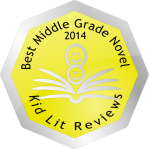 Best Middle Grade Novel
Best Middle Grade Novel
The Guardian Herd #1: Starfire
Author: Jennifer Lynn Alvarez
Cover Artist: David McClellan
Publisher: HarperCollins Children’s Books (September 23, 2014)
x
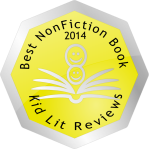 Best Nonfiction Book
Best Nonfiction Book
Josephine: The Dazzling Life of Josephine Baker
Author: Patricia Hruby Powell
Illustrator: Christian Robinson
Publisher: Chronicle Books (January 14, 2014)
x
 Best Poetry Book
Best Poetry Book
Rhyme Schemer
Author: K. A. Holt
Publisher: Chronicle Books (October 1, 2014)
x
 Best Holiday Book
Best Holiday Book
Lobo’s Howliday (The Adventures of Loveable Lobo #5)
Author: C. L. Murphy
Illustrator: C. L. Murphy
Publisher: Peanut Butter Prose (December 1, 2013)

 WINNERS: I can offer you the files for your “stamp,” if you are interested. Otherwise this is more bragging rights than anything. Please email (or use contact form). Once again, congratulations to all the winners!
WINNERS: I can offer you the files for your “stamp,” if you are interested. Otherwise this is more bragging rights than anything. Please email (or use contact form). Once again, congratulations to all the winners!

(flags and reading cat © Laura Strickland @ My Cute Graphics)
Filed under:
Children's Books,
Holiday Book,
Library Donated Books,
Middle Grade,
NonFiction,
Picture Book,
Poetry,
Top 10 of 2014 Tagged:
2014 best books on KLR,
C.L. Murphy,
Christian Robinson,
Chronicle Books,
David McClellan,
Eliza Wheeler,
HarperCollins Children’s Books,
Jennifer Lynn Alvarez,
Josephine: The Dazzling Life of Josephine Baker,
K.A. Holt,
Lobo’s Howliday (The Adventures of Loveable Lobo #5),
Mara Rockliff,
Patricia Hruby Powell,
Peachtree Publishers,
Peanut Butter Prose,
Rhyme Schemer,
The Grudge Keeper,
The Guardian Herd #1: Starfire 







By:
Sue Morris,
on 9/11/2014
Blog:
Kid Lit Reviews
(
Login to Add to MyJacketFlap)
JacketFlap tags:
Children's Books,
Picture Book,
Favorites,
Series,
children's book reviews,
Debut Author,
Library Donated Books,
Amazon Children's Publishing,
Two Lions,
6 Stars TOP BOOK,
Top 10 of 2014,
Anna Kang,
Christopher Weyant,
Add a tag
 x
x
x
You Are (Not) Small
Written by Anna Kang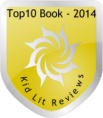
Illustrated by Christopher Weyant
Two Lions 8/05/2014
978-1-47784772-5
Age 4 to 8 32 pages
x
x
x
“Two fuzzy creatures can’t agree on who is small and who is big, until a couple of surprise guests show up, settling it once and for all! Size all depends on who’s standing next to you.”
Opening
“You are small.”
Review
Two funny, hairy purple and orange creatures square off and let the other know about their size: big or small. The orange creature tells the purple creature that he is small. The purple creature responds that he is not small, but the orange creature is big. Orange denies being big, despite towering over the purple, who denies being small, despite barely coming up the orange creature’s waist. STOP! What is going on with these two? Don’t they see the obvious?
Nope, they sure do not. The big guy denies he is big, bringing in others just like him to prove his point.

“They are just like me.”
Huh? The little creature brings in others just like him and he, too makes the same point. This argument is not logical, but young kids will not care. Honestly, in my first read-through, which is always for fun, I didn’t give much to the faulty logic either. I doubt I even noticed it—laughing excessively, wiping tears from my sparkling eyes, and holding my laugh-cramped stomach. Then the interaction gets a tad intense. Voices get louder.
“You are all small!’
“You are all big!”
“Small!”
“Big!”
Each of the supporting groups has interesting reactions. At first, the purple creatures look on, one wide-eyed (love it), but the orange creature’s are less interested. One even rolls his eyes (love it, more). Ratchet up the tension and voices. Everyone is now involved. This plot, the characters, the twist at the end all make for a charming book no young child should be without.
Five colors and a white background make perfect illustrations for this story. The black outlining brings character and emotions to these hairy big and small creatures. Their rotund figures remind me of polar bears. I love the small dot eyes. The comical noses on these creatures are huge and terrific. Add in the mitten-like hands and these creatures are all thumbs and harmless. Oversized text compliments these terrific illustrations, which children and their parents will love—enough to read many successive times.
“BOOM”
Whoa! What was that? Two huge feet— each foot half a page in width—and two legs, cut off before the knee, slam down in the middle of the lively argument. The green, hairy creature is humongous! Tiny pink creatures find their way down by way of yellow parachutes. Purple and orange creatures look up with varying interest; including a wide-eyed, purple creature and a glasses wearing orange creature with a content smile (love the small details). Many of the creatures on both sides are smiling. Combatant purple looks to his orange sparring partner, points to one pink creatures and says,
“See? I am not small.”
Misunderstood orange, wearing a big smile, points to the green creature that dropped in only moments before, and says,
“See? I am not big.”
Notice, there are no exclamation points in either statement. The two creatures have come to a conclusion. Both sides smile, one declares something, and off everyone goes, happy as if no argument ever occurred. Lesson: your size is relative to whom you are standing near. You can be both small and big!

You Are (Not) Small has one of the funniest twists/lead-ins to a next book I have read in a while. Aside from the back matter telling us the author/illustrator team of Kang and Weyant are working on a sequel, the final spread gives it away. Kids will grab up the sequel as fast as the books hit the shelves. Pre-order the sequel now, well, if you could, but you cannot. What a shame.
Kids will howl at the twist, never having seen it coming until it hits. All readers, young and old, big and small, will adore this crazy book about size’s relative nature, be it of girth or problem. There is always going to be one bigger and smaller than yours.
Go get You Are (Not) Small right now. Read it every night—you will do this voluntarily. Read it to the kids, if you want. They will love it as much as you will. Laugh every day. Cry every day (from laughing). Then, when the new book is announced, pre-order as fast as your small, uh, big, uh . . . just do it. Wonderful debut from this husband / wife team. Up next: That is (Not) Mine 2015
YOU ARE (NOT) SMALL. Text copyright © 2014 by Anna Kang. Illustrations copyright © 2014 by Christopher Weyant. Reproduced by permission of the publisher, Two Lions, New York, NY.
x
Buy You Are (Not) Small at Amazon —B&N—Book Depository—Two Lions—your favorite bookstore.
—B&N—Book Depository—Two Lions—your favorite bookstore.
x
Learn more about You Are (Not) Small HERE.
Meet the author, Anna Kang, at her facebook: https://www.facebook.com/YouAreNotSmall
Meet the illustrator, Christopher Weyant, at his website: http://christopherweyant.com/
Find more picture books to laugh at the Two Lions’ website: http://www.apub.com/imprints
Two Lions is an imprint of Amazon Children’s Publishing
An interview with Anna Kang
Art: India ink and watercolor
x
Also by Anna Kang & Christopher Weyant
That is (Not) Mine 2015
x

x
Copyright © 2014 by Sue Morris/Kid Lit Reviews
Filed under:
6 Stars TOP BOOK,
Children's Books,
Debut Author,
Favorites,
Library Donated Books,
Picture Book,
Series,
Top 10 of 2014 Tagged:
Amazon Children's Publishing,
Anna Kang,
children's book reviews,
Christopher Weyant,
debut author,
picture book,
Two Lions 







By:
Sue Morris,
on 9/9/2014
Blog:
Kid Lit Reviews
(
Login to Add to MyJacketFlap)
JacketFlap tags:
Children's Books,
Picture Book,
picture books,
NonFiction,
nature,
Favorites,
Chronicle Books,
children's book reviews,
Library Donated Books,
Lizi Boyd,
6 Stars TOP BOOK,
Top 10 of 2014,
backkyard camp-out,
illustrations only,
Add a tag
 x
x
x
Flashlight
Written and illustrated by Lizi Boyd
Chronicle Books 8/01/2014
978-1-4521-1894-9
Age 2 to 6 32 pages
x
x
“Inside the tent it’s cozy. But what is going on outside? Is it dark? Is it scary? Not if you have your trusty flashlight! Told solely through images and using a spare yet dramatic palette, artist Lizi Boyd has crafted a masterful exploration of night, nature, and art. Both lyrical and humorous, this visual poem—like the flashlight beam itself—reveals that there is magic in the darkness. We just have to look for it.”
Opening
The young girl, let’s call her Amy, is outside with her flashlight, shining it on the ground. Look! she has found a mouse, no three mice, going about their nighttime activities. Looking up with her flashlight beam, Amy finds an owl, which looks a little spooked that Amy found it in its tree.

Review
Flashlight is an amazing picture book. Without words, “Amy” has a nighttime adventure of a lifetime. With her flashlight, Amy finds all sorts of animals, but misses just as many who are in the dark. She spies an owl in a tree, a couple of fish in a pond, a fox, and doe with her two babies. If this is not the best adventure for a young child, I cannot think of what could be better. The artist strategically added a hole placed in each spread that focuses upon something the young girl does not see in the dark, but the reader now can. I like that little change that holds more surprises for the reader.
Oops! Amy tripped on stone, tossing the flashlight onto the ground. A raccoon has the flashlight and is lighting up Amy’s face. It passes the flashlight to a beaver, which lights up Amy’s backside. The animals continue to pass off the flashlight until the owl takes possession, pointing the light onto the opening of Amy’s tent. I believe the owl, as wise as it is, thinks Amy should be in bed. Amy tucks in then reads a story to the three mice. I wonder what the story she is reading those three mice.

Flashlight is an amazing nighttime adventure right in the young girl’s backyard or park, there is no way to be sure. She enjoys finding the animals as well as young children will enjoy finding them. I enjoyed it. There are so many stories kids can imagine with each animal and what they are doing at might. Why does the wise owl want Amy to stop flashing its friends and go to sleep inside the tent? Is he worried about her sleep, or does he want her to stop interfering with the animals nighttime routines?
Children and parents will love this picture book adventure, as do I. Read as a bedtime story, Flashlight can about the young girl or the animals. Parents and their child will enjoy discovering the different animals. How wonderful that could be. The illustrations are all on black paper, with silver-lined animals (in the dark) and colorful animals as the flashlight shines upon them. Flashlight is a magnificent picture book and one of the most original I have seen this year.

Flashlight is a Junior Library Guild selection for 2014.
FLASHLIGHT. Text and illustrations copyright © 2014 by Lizi Boyd. Reproduced by permission of the publisher, Chronicle Books, San Francisco, CA.
Three Questions with Lizi Boyd
x
Purchase Flashlight at Amazon —B&N—Book Depository—Chronicle Books—at your favorite bookstore.
—B&N—Book Depository—Chronicle Books—at your favorite bookstore.
Learn more about Flashlight HERE.
Meet the author/illustrator, Lizi Boyd, at her website: http://liziboyd.com/
Find more magnificent books at the Chronicle Books’ website: http://www.chroniclebooks.com/
x
Also by Lizi Boyd

Inside Outside

Black Dog Gets Dresssed

I Love Mommy

I Love Daddy

Copyright © 2014 by Sue Morris/Kid Lit Reviews
Filed under:
6 Stars TOP BOOK,
Children's Books,
Favorites,
Library Donated Books,
NonFiction,
Picture Book,
Top 10 of 2014 Tagged:
backkyard camp-out,
children's book reviews,
Chronicle Books,
illustrations only,
Lizi Boyd,
nature,
picture books 







By:
Sue Morris,
on 9/7/2014
Blog:
Kid Lit Reviews
(
Login to Add to MyJacketFlap)
JacketFlap tags:
absent parents,
K.A. Holt,
Library Donated Books,
bullied,
6 Stars TOP BOOK,
Top 10 of 2014,
bullier,
seventh grade,
Poetry,
Middle Grade,
Favorites,
Chronicle Books,
poems,
Reluctant Readers,
children's book reviews,
Books for Boys,
middle grade novel,
Add a tag
 x
x
x
Rhyme Schemer
Written by K. A. Holt
Chronicle Books 10/01/2014
978-1-4521-2700-2
Age 8 to 12 176 pages
x
x
“Kevin has a bad attitude. He’s the one who laughs when you trip and fall. In fact, he may have been the one who tripped you in the first place. He has a real knack for rubbing people the wrong way—and he’s even figured out a secret way to do it with poems. But what happens when the tables are turned and he is the one getting picked on?”
Opening
“First day of school.
My favorite.
Easy prey.
Giant John.
A parade float of himself.
The Story
Kevin, the class bully, is in seventh grade. He loves picking on certain kids. His teacher, Mrs. Smithson, does not like him, but does like to send Kevin to the principal’s office. She also turns a very blind eye when Kevin is no longer the bully, but the bullied. At home, Kevin is the accident baby with four “P” brothers: Patrick, Paul, Petey, and Philip. Mom and dad are both busy physicians with little time for home or Kevin.
Kevin keeps a notebook of his days at school, writing them in verse. Petey, in charge of driving Kevin to school, is a bully himself. When he notices Kevin’s notebook, Petey makes terrible fun of Kevin and then chucks the notebook out the car window. Kevin searches but cannot find it. Robin, who fits perfectly between the boy’s bathroom sink pipes, finds the notebook. It becomes blackmail. Robin wants to be the Poetry Bandit. Robin is a little jerk.
Mrs. Little, the librarian, knows it is Kevin tearing out pages from classics, circling and adding a letter or two, creating a unique poem, and then posting it at school for all to see. Mrs. Little soon takes to Kevin. She encourages Kevin to stop defacing school property and use paper other than pages from children’s classics for his unique poetry. As long as Robin has Kevin’s private notebook, sharing it at random, Kevin is nervous. There are a few bombs in the notebook that Kevin does not want exploding at school.
Review
Written in verse, Rhyme Schemer is a fast read. It is also an extremely enjoyable read that kept me laughing, sometimes loudly. Kevin is not a bad kid. His home life looks ideal to others, but reality is another matter. His parents are rarely home and brother Petey—who hates Kevin—is especially mean whenever possible. Bullies beget bullies. Kevin enjoys picking on his classmates. He meets with the principal much too often.
Kevin is not the classic bully who is mean and full of hate that spews out at other kids. Kevin is frustrated and trying to get his parent’s attention. His home life is mostly unfair and soon school will become unfair. The teacher ignores Robin’s attacks at Kevin, whether it is passing mean notes during class or ignoring a physical confrontation—where Kevin does not retaliate. She really does not like Kevin and then favors Robin, mainly because his father holds an important position.
I really like Kevin. He is a character you can easily favor, wanting him to catch a break. He’s a likable kid. Kevin pays a big price for defending Kelly, but he gains a friend, his first. I understand Kevin. He is the baby in a large family, but instead of being spoiled, he is picked on, sometimes harshly for no real reason. In a house full of people, Kevin is alone. What must it be like to have four brothers, all wanted, and with planned-out names beginning with a “P” (I wish I knew why), but he is the accident with a name beginning with the wrong letter. This alone must make him feel alienated from his family. Kevin deals with school unfairness and home by becoming a feeling-less, like stone.
Kids will like Rhyme Schemer. They will like Kevin. Kids will see a bully from a new perspective. The text is funny in so many places, and even sad in a few. Ms. Holt’s writing style is enjoyable and kid like. Kevin is the narrator, but I wonder if he is also the author and Ms. Holt his conduit. Kevin wrote several Odes to his principal’s tie. Some are in the story and some are at the end of the book. Don’t pass these by.
“[Clearing throat noise here.]
x
O, Principal’s tie
You make me want to puke
Because you are the color of
Squishy, moldy fruit”
Reluctant readers will also find Rhyme Schemer easy to read. At the end, I was not ready to stop reading. I wanted more. There are no unanswered questions, no threads laying in wait for a resolution; I simply want to read more of Kevin’s poetry. Rhyme Schemer is one of those rare books that stay with you, long after the last page flips over. I hope to read Kevin’s eighth grade notebook.
RHYME SCHEMER. Text copyright © 214 by K. A. Holt. Reproduced by permission of the publisher, Chronicle Books, San Francisco, CA.
Read a excerpt of Rhyme Schemer HERE (no cost)
Buy Rhyme Schemer at Amazon —B&N—Book Depository—Chronicle Books—your favorite bookstore.
—B&N—Book Depository—Chronicle Books—your favorite bookstore.
Learn more about Rhyme Schemer HERE
Meet the author, K. A. Holt, at her website: http://kaholt.com/books/
Find more middle grade books at the Chronicle Books website: http://www.chroniclebooks.com/
Also by K. A. Holt

Brains for Lunch

Mike Steller Nerves of Steel
Coming Fall 2015 – House Arrest – Chronicle Books

Copyright © 2014 by Sue Morris/Kid Lit Reviews
I really like the author information on the back inside book jacket.
x
“K. A. Holt is a writer
a mama
a bad (but fearless) cook.
She has written three
(three!)
books for kids.
Also?
She shelved books
in the library
during grade school.
Ms. Holt claims
(claims!)
she never had a detention.
Believe what you want.”
Filed under:
6 Stars TOP BOOK,
Books for Boys,
Favorites,
Library Donated Books,
Middle Grade,
Poetry,
Reluctant Readers,
Top 10 of 2014 Tagged:
absent parents,
bullied,
bullier,
children's book reviews,
Chronicle Books,
K.A. Holt,
middle grade novel,
poems,
poetry,
seventh grade 







By:
Sue Morris,
on 8/31/2014
Blog:
Kid Lit Reviews
(
Login to Add to MyJacketFlap)
JacketFlap tags:
Middle Grade,
Favorites,
Series,
children's book reviews,
middle grade novel,
Debut Author,
Pegasus,
HarperCollins Publishers,
Library Donated Books,
6 Stars TOP BOOK,
Top 10 of 2014,
Jennifer Lynn Alvarez,
Guardian Herd,
HarperCollins Children’s Books,
Hundred Year Star,
Land of Anok,
Starfire,
Add a tag

x
The Guardian Herd #1: Starfire
Written by Jennifer Lynn Alvarez
Harper/HarperCollins Children’s Books 9/23/2014
978-0-06-228606-2
Age 8 to 12 272 pages
x
x
“Once every hundred years, a black foal is born, prophesied to either unite or destroy the five herds of flying horses that live in the land of Anok. He is fated to become the most powerful Pegasus in all of Anok. Star is this black foal. Even though Star has malformed wings that make him unable to fly, the leaders of each herd will take no risks and want to execute Star before his first birthday. With the help of his friends, Star must escape the clutches of the powerful leaders. His epic journey of self-discovery turns into a battle between good and evil that will keep readers eagerly turning the pages.”
Opening
“Star trotted through the dense pine forest, alone.”
The Story
The Pegasi of Anok (mythical winged horses), consists of five herds each with their own leader—the over-stallions—and their own land. None crosses the borders without permission. Wars have been raging between these herds for hundreds of years. Star is a black foal born into the Sun Herd, led by Thunderwing. When Star’s mother died birthing Star, Thunderwing’s mate adopted him, much against her mate’s wishes.
Star, a black foal, was born under the Hundred Year Star. If he can remain alive until his first birthday, he will receive the star’s power, and then become either a destroyer or a healer. No one knows which he will become, not even Star, and this terrifies the over-stallions of each herd. The last black foal born under this star all thought would be a healer. He was a good weanling, but when he received the power, he became a destroyer and wrecked havoc in all the land of Anok. It is up to the over-stallion of the guardian herd—Thunderwing—to kill the black foal before his first birthday, or to let him live and receive his ultimate power. Thunderwing is as scared as the others are and plans to execute Star before his first birthday.
Only Star’s three friends and his adopted mother believe Star will be a healer and seek to keep Star alive so he can receive the power of the Hundred Year Star. The other weanlings (those under one-year of age) bully Star and his three friends, mainly because he cannot fly. He does not fit into his wings, and must walk every like a common horse—a terrible insult to a Pegasus.
One particular weanling has it in for Star and tries to kill him. But in doing so, he crosses into another herd’s land, starting a war. Between this new war and the majority of pegasi wanting him executed, Star knows he must be on his own. Can Star survive without his friends, tend to his own food and water, and remain hidden from all other pegasi? Whether or not Star can survive on his own will greatly determine his future. With five herds looking for him, Star’s odds of survival are slim.
Review
The Guardian Herd has every element a kid wants in an adventure. The author has created an imaginative, highly stylized world kids will appreciate. There are great characters that are easy to understand and like, even the terrifying bully Brackentail. This adventure has tons of action, some with violence. The violence is not bad until the final battle, making this book more appropriate for middle graders on the older end of their age-range.
There are many characters is The Guardian Herd. So many that the author starts with five pages of descriptions so kids know the herds and the pegasi in each herd. I found this section a tad overwhelming and skipped it altogether. I had no trouble remembering who was who and where they belonged. The only thing this list does, in my opinion, is make the story seem cumbersome and it might scare off a reader or two. I would drop it or place it at the end of the story.
Star is a wonderful character. Despite his worthless wings and inability to fly, Star has a warm personality, respects and honors his friends and adopted mare, and is braver than one would think given his situation and fate. Star is a character whose side you will quickly take up. When off on his own, Star’s humor—or the author’s humorous writing—had me in stitches. I loved his friend Crabwing and the things they did in and around the bay.
Granted, there is a huge war near the end of the story and the violence can be just shy of young adult territory, but I do not think it will give any kid nightmares, especially when the scenes that follow these battles are as strong and easy to envision. Once these scenes begin, the war becomes a distant memory. I think these final scenes will override any violent scenes a kid may linger on. The ending is extremely well written and strong. It was nothing as I imagined it might be. I cannot explain any further without spoilers, so this will have to do: the ending is fantastic. If the author does not hurry up and finish the next book, I may start stalking her blog.
The Guardian Herd may not be a New York Bestseller, yet, but it will entertain, and possibly teach your child a few things about friendship, respect, and loyalty. If not, they will still be completely engrossed for a few hours with an imaginative world that actually resembles our own world in many ways. I highly recommend this series for kids age 10 and up. Adults who love fantasy adventures will also enjoy The Guardian Herd #1: Starfire. This is Jennifer’s debut novel with HarperCollins—her first traditionally published book!
THE GUARDIAN HERD #1: STARFIRE. Text copyright © 2014 by Jennifer Lynn Alvarez. Advanced Readers Copy received from the publisher, HarperCollins Children’s Books, New York, NY.
x
Get your copy of The Guardian Herd: Starfire at Amazon —B&N—Book Depository—HarperCollins—your favorite book store.
—B&N—Book Depository—HarperCollins—your favorite book store.
Learn more about The Guardian Herd: Starfire HERE
**Also Available in Audio
Meet the author, Jennifer Lynn Alvarez, at her website: http://www.jenniferlynnalvarez.com/
Find more exciting stories at the HarperCollins website: http://www.harpercollins.com/
HarperCollins Children’s Books is an imprint of HarperCollins Publishers.
Here is a twelve-year-old kid’s view of The Guardian Herd #1: Starfire. Read Erik’s review HERE
x
Also by Jennifer Lynn Alvarez

The Pet Washer
x
x
x
Reviewed HERE
x
x

x
Copyright © 2014 by Sue Morris/Kid Lit Reviews
Filed under:
6 Stars TOP BOOK,
Debut Author,
Favorites,
Library Donated Books,
Middle Grade,
Series,
Top 10 of 2014 Tagged:
children's book reviews,
Guardian Herd,
HarperCollins Children’s Books,
HarperCollins Publishers,
Hundred Year Star,
Jennifer Lynn Alvarez,
Land of Anok,
middle grade novel,
Pegasus,
Starfire 







By:
Sue Morris,
on 8/27/2014
Blog:
Kid Lit Reviews
(
Login to Add to MyJacketFlap)
JacketFlap tags:
Children's Books,
penguins,
Picture Book,
picture books,
ballet,
Favorites,
Chronicle Books,
Series,
children's book reviews,
ice skating,
Molly Idle,
Library Donated Books,
6 Stars TOP BOOK,
Top 10 of 2014,
Flora and the Penguin,
gorgeous illustrations,
wordless stories,
Add a tag
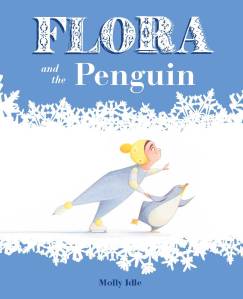
x
Flora and the Penguin
Written and illustrated by Molly Idle
Published by Chronicle Books 2014
978-1-4521-2891-7
Age 4 to 8 (+) 32 pages
x
x
“Flora is back and this time she partners with a penguin. Twirling, leaping, and gliding on skates and flippers, the duo mirror each other in an exuberant ice dance. But when Flora gives the penguin the cold shoulder, the pair must figure out a way to work together for uplifting results.”
Opening
As Flora ties her right skate, she notices something poke out of a hole in the ice. What could it be?
Review
Flora is back at the ice rink, getting ready to glide and twirl when she sees something odd in the hole across from where she sits lacing her skate. Flora extends her hand, offering it to Penguin. He accepts (I am assuming Penguin is a he, I really do not know). Flipper in hand, the pair glide in perfect harmony. Left foot glide to the right; turn and right foot glide to the left. In absolute harmony, Flora and Penguin take off and then LEAP into a perfect twirl.
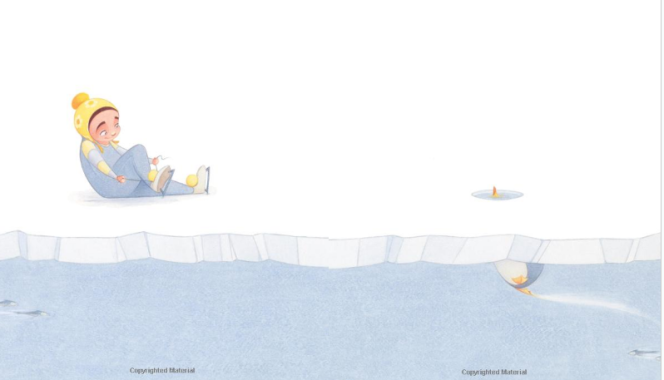
Oh, NO! Penguin misses his landing, falling onto his rotund rear. Flora glides away . . . laughing. Penguin belly slides to her with a twinkle in his eye. This is not Flora and the Flamingo. The grace and style are present. The harmonious duet is there. The serious business of skating is not. Penguin brings the smiles and laughs out of Flora. He also spoils his partner, or, rather, he tries. Flora rejects Penguin’s gift. Sure, it is a small fish he has brought her; a snack Penguin chased below the ice—in synchronicity with Flora’s skating. Flora flips the fish over her head. Penguin looks mortified as his gift somehow lands into the hole in the ice and swims away.
The beautiful illustrations once again capture the elegant characters gliding, twirling, and leaping. At quick glance, one might believe this is the Caldecott Honor Book Flora and the Flamingo, only with a penguin. That person would be wrong, terribly wrong. In Flora and the Flamingo, Flora is the student learning from Flamingo, the teacher. In Flora and the Penguin, Flora is no longer the student, nor is she the teacher. She and Penguin are friends skating together and having fun. When Penguin misses his landing, no one turns away in admonition. No, Flora happily laughs and Penguin giggles as they join back together. These two are playmates.
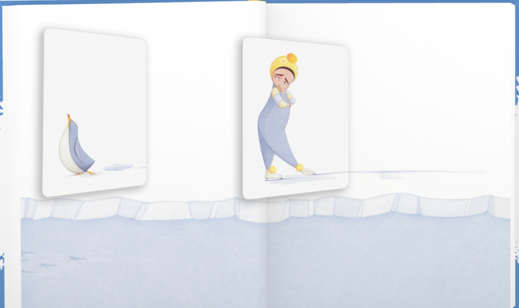
Playmates have fights, as you are sure to remember. Flora turns away in a pout, checking on Penguin when he looks away. Penguin is also pouting in anger and keeping an eye on Flora. These two friends need to find their way back and Ms. Idle does this in grand style. A four-page grand spread. Flora and the Penguin is a gorgeous, wordless picture book that will wow anyone lucky enough to turn the pages. Some pages contain flip-up, -down, or –sideways, always changing the scene and promoting a smile.
Flora and the Penguin is an easy choice for anyone who loves ballet. Yet this gorgeous, should-win-lots-of-awards picture book will attract a wider audience. Like her throngs of admirers, I cannot wait for her next release, though I am secretly hoping for new characters in a new story. Whatever direction she takes, parents and young children will love the finished product. Ms. Idle has perfected the art of wordless storytelling.
FLORA AND THE PENGUIN. Text and illustrations copyright © 2014 by Molly Idle. Reproduced by permission of the publisher, Chronicle Books, San Francisco, CA.
x
Buy Flora and the Penguin at Amazon —iTunes—B&N—Book Depository—Chronicle Books—your favorite bookstore.
—iTunes—B&N—Book Depository—Chronicle Books—your favorite bookstore.
Learn more about Flora and the Penguin HERE
Meet the author/illustrator, Molly Idle, at her website: http://idleillustration.com/
Find more picture books at the Chronicle Books’ website: http://www.chroniclebooks.com/
x
Also by Molly Idle
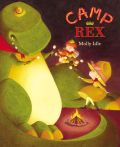
Camp Rex
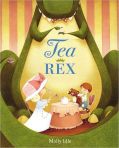
Tea Rex
x
x
x
x
x
x

x
Copyright © 2014 by Sue Morris/Kid Lit Reviews
Filed under:
6 Stars TOP BOOK,
Children's Books,
Favorites,
Library Donated Books,
Picture Book,
Series,
Top 10 of 2014 Tagged:
ballet,
children's book reviews,
Chronicle Books,
Flora and the Penguin,
gorgeous illustrations,
ice skating,
Molly Idle,
penguins,
picture books,
wordless stories 







By:
Sue Morris,
on 8/20/2014
Blog:
Kid Lit Reviews
(
Login to Add to MyJacketFlap)
JacketFlap tags:
Children's Books,
Picture Book,
Poetry,
NonFiction,
Favorites,
children's book reviews,
Millbrook Press,
Irene Latham,
African animals,
Library Donated Books,
6 Stars TOP BOOK,
Top 10 of 2014,
Lerner Publishing Group Inc.,
Anna Wadham,
Add a tag
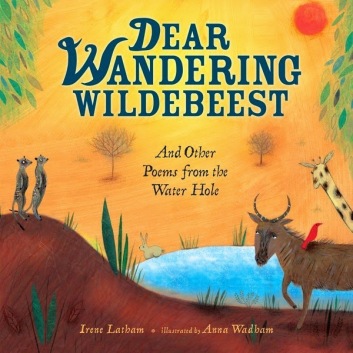 x
x
Dear Wandering Wildebeest: And Other Poems from the Water Hole
Written by Irene Latham
Illustrated by Anna Wadham
Millbrook Press 8/01/2014
978-1-4677-1232-3
Age 4 to 8 32 pages
x
x

x
x
x
x
“Welcome wildebeest
and beetle,
oxpecker and lion.
This water hole is yours.
It offers you oasis
beside its shrinking shores.
“Spend a day at a water hole in the African grasslands. From dawn to nightfall, animals come and go. Giraffes gulp, wildebeest graze, impalas leap, vultures squabble, and elephants wallow. Irene Latham’s gorgeous poems are accompanied by additional facts that provide further details about the animals and their environment. Imaginative illustrations from Wadham complete this delightful collection.”
Review
Dear Wandering Wildebeest, is composed of 15 poems about wild African animals, a glossary of possibly unusual words, and a section of advanced reading, enhanced by beautiful illustrations of the animals and the African land in which they live.
If you like giraffes, monkeys, lions, and elephants, you are in luck. There are also rhinoceros, small nightjars, vultures, marabou storks, oxpeckers, and, of course, wildebeest. Don’t worry, there are many more animals than that in this wonderful book. The pages look like the African Plains have jump onto the paper, leaving nothing bare. The beautiful skies change with the day, sometimes the dark blue of midnight or the rosy shade of dusk.
Some of the poems rhyme and some do not, but all are easy to read aloud. Impala Explosion swiftly jumps off the reader’s tongue.
“Wind lifts
grass shifts
eyes search
legs lurch
twig pop
grazing stops
ears twitch
tails hitch
peace shatters . . .”
—Impala Explosion, (partial poem) by Irene Latham © 2014
x
x
Kids will love the poems. They will understand them all, and any word that is foreign to them is most likely sitting in the glossary waiting to spread some understanding. If you like the aforementioned giraffes, Ms. Latham wrote a triptych in its honor. What is a triptych, you ask? I have no idea, but the glossary knows. Let’s check.
“triptych: a work of art divided into three sections”
That would be correct. The giraffe’s poem is divided into three sections:
Craving,
Caution, and
Courage.”
Feeling parched, the giraffe craves a drink. Giraffe’s must be cautious, as it has no idea what other animals will be at the water hole. It could be dangerous. To quench its thirst, the giraffe must be courageous and confident because other animals will pounce on a weak animal. Giraffes are cool creatures. If the poem does not convince you of this, read the information box in the lower left side of the spread.
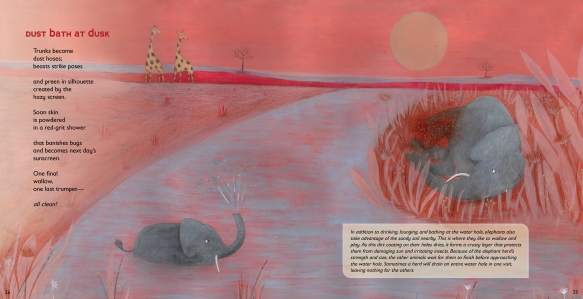
Each spread has an information box containing interesting things about the animal or animals illustrated. I really like the information the author/poet adds to the spread, much of it new information that I found fascinating. For instance, did you know the impala could jump as high as eight feet? Eight feet! That is high enough to clear the privacy fence in your backyard, if you have one, and have two feet between the top of the fence and the impala’s belly. How about this, in one year, the wildebeest travels—looking for food—more than 800 miles across the Serengeti. This is equivalent to you traveling across the state of Kansas, east to west (or west to east) twice, or the state of Rhode Island from north to south (or south to north) a whopping 20 times! The extra information is very interesting.
The illustrations are simply gorgeous. The African animals depicted in detail and the landscapes of various colors are easily as beautiful as the animals—except maybe snakes. I do not like snakes. If you do, they are covered and you will think they are beautiful. Check out each animal’s eyes. There is always something going on that draws their attention. (I think that darn snake is looking at me!) There is so much to see on each spread.
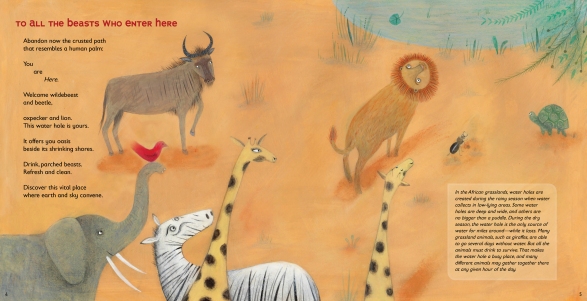
Dear Wandering Wildebeest is one of those picture books that will delight nearly 99% of those most who read its poems and view its lovely art. Kids, you will love the animals, the sometimes-quirky poems, the illustrations, and all the interesting side information about life at an Africa watering hole for the wild creatures that need it for survival. If you love poetry and animals, Dear Wandering Wildebeest is a book is for you. It is really that simple. With school right around the corner, Dear Wandering Wildebeest is perfect book for show and tell or light research for a book report on an African watering hole and the animals that depend upon it.
DEAR WANDERING WILDEBEEST: AND OTHER POEMS FROM THE WATER HOLE. Text copyright © 2014 by Irene Latham. Illustrations copyright © 2014 by Anna Wadham. Reproduced by permission of the publisher, Millbrook Press, Minneapolis, MN.
Purchase a copy of Dear Wandering Wildebeest: And Other Poems from the Water Hole at Amazon —B&N—Book Depository—Millbrook Press—your favorite bookstore.
—B&N—Book Depository—Millbrook Press—your favorite bookstore.
x
Learn more about Dear Wandering Wildebeest: And Other Poems from the Water Hole HERE.
Meet the author/poet, Irene Latham, at her website: http://www.irenelatham.com/
Meet the illustrator, Anna Wadham, at her website: http://annawadham.blogspot.com/
You can find more poetry at the Millbrook Press website: https://www.lernerbooks.com/
Millbrook Press is a division of Lerner Publishing Group, Inc.
x
Also by Irene Latham

The Sky Between Us

Don’t Feed the Boy
Read Review HERE.
Also by Anna Wadham

The Ant and the Big Bad Bully Goat

Dingo Dog and the Billabong Storm
x
x

x
x
Copyright © 2014 by Sue Morris/Kid Lit Reviews
Filed under:
6 Stars TOP BOOK,
Children's Books,
Favorites,
Library Donated Books,
NonFiction,
Picture Book,
Poetry,
Top 10 of 2014 Tagged:
African animals,
Anna Wadham,
children's book reviews,
Irene Latham,
Lerner Publishing Group Inc.,
Millbrook Press,
picture book,
poetry 







By:
Sue Morris,
on 8/15/2014
Blog:
Kid Lit Reviews
(
Login to Add to MyJacketFlap)
JacketFlap tags:
6 Stars TOP BOOK,
Top 10 of 2014,
Caldecott Honnor Book,
girl's picture book,
poetry in motion,
Children's Books,
penguins,
Picture Book,
dance,
birds,
ballet,
Favorites,
Chronicle Books,
children's book reviews,
flamingo,
Molly Idle,
Library Donated Books,
Add a tag
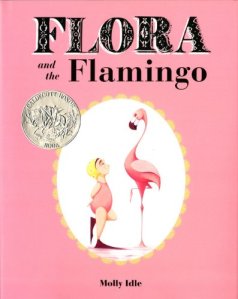 x
x
Flora and the Flamingo
by Molly Idle
Chronicle Books 2013
978-1-4521-1006-6 CALDECOTT HONOR BOOK
Age 4 to 8 32 pages
x
x
“Friendship is a beautiful dance. In this innovative wordless book, a tentative partnership blooms into an unlikely friendship between a girl named Flora and a graceful flamingo. With a twist, a turn, and even a flop, these unlikely friends learn at last how to dance together in perfect harmony. Artist Molly Idle has created a story full of humor and heart, with emotions that leap off the page, and memorable characters who are worthy of countless standing ovations.”
Opening
A flamingo, peacefully standing one-legged in the water, turns its head to look behind it and eyes one little girl, named Flora, standing one-legged in the water, imitating the flamingo, who then turns her head to look behind her.
Review
Do you remember repeating everything your older sibling said or mimicking every movement, just because you could? Flora mimics the flamingo, but not to get the flamingo’s goat. The little girl, in her pink one-piece swimsuit and pink flowered swim cap, takes on the flamingo’s graceful movements and the two begin a beautiful duet.
Words would undeniably be a distraction in the story of Flora and the Flamingo. Movement flows from a variety of flip pages attached atop Flora or the flamingo on several of the pages. For example, Flora imitates the flamingo’s stance: standing on one leg, head tucked under a wing. Flip down the flaps and the stances change. Both dancers remain on one leg, but now each twists her head toward the other, possibly checking to ensure the other is still there.

The flamingo is Flora’s mirror, or maybe Flora is the flamingo’s mirror. Each bend, each stretch, each turn, and each look magically appear on both characters at the same time. Flora and the Flamingo will make you giggle and grin. Young girls will love the mystical dance between these two unlikeliest of friends. Before a friendship can be established, the flamingo LETS Flora have it! The shock of flamingo’s sharp bleat flips Flora over and up, landing her on her rear, unhappy. Flora turns her back, refusing to play any longer, but the flamingo finds this worse than being shadowed. It offers Flora a wing, which Flora thinks about before allowing flamingo to help her to her feet. (Are these two friends or siblings?)
At the moment of friendship, when Flora and the flamingo become dancing partners instead of solo acts, the spread takes on a drastic change. The two begin together on one page. They had begun their awkward dance with the flamingo firmly staying on the left page and Flora on the opposing right page of the spread. Now both are on the right page, figuratively and physically. Their movements become wider, and joyous. The two fly across the spread, smiling as they float, as if on ice. Then there is a big finale, as all great ballets should have. The finale is a wonderful dance only Flora and her flamingo can perform, together in the same spotlight, four pages in length. BRAVO!

Girls will love this graceful dance between friends, especially those little girls starting their first ballet lessons, wearing their pink tutus, and pink leotards, and some with pink ballet shoes, while others still will have pink ribbons in their hair. Flora is at her first class and flamingo is the instructor. This makes a wonderful baby-shower gift, when the parents-to-be know they have a girl on the way. Flora and the Flamingo is a beautiful book, with brilliant illustrations that float across the pages. It is no surprise Flora and the Flamingo became a Caldecott Honor Book. The medal winner must have been an amazingly illustrated picture book to beat out these two graceful dancers.
FLORA AND THE FLAMINGO. Story and Illustrations copyright © 2013 by Molly Idle. Reproduced by permission of the publisher, Chronicle Books, San Francisco, CA.
Purchase Flora and the Flamingo at Amazon —B&N—Book Depository—iTunes—Chronicle Books—your favorite bookstore.
—B&N—Book Depository—iTunes—Chronicle Books—your favorite bookstore.
x
Learn more about Flora and the Flamingo HERE.
Meet the author / illustrator, Molly Idle, at her website: http://idleillustration.com/
Find more books that are luscious at the Chronicle Books website: http://www.chroniclebooks.com/
x
Also by Molly Idle
FLORA AND THE PENGUIN 2014
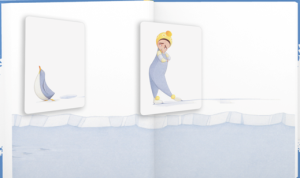
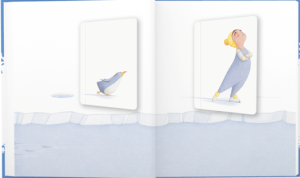
x
x
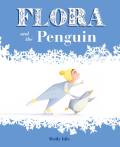
Flora and the Penguin
2014
Filed under:
6 Stars TOP BOOK,
Children's Books,
Favorites,
Library Donated Books,
Picture Book,
Top 10 of 2014 Tagged:
ballet,
birds,
Caldecott Honnor Book,
children's book reviews,
Chronicle Books,
dance,
flamingo,
girl's picture book,
Molly Idle,
penguins,
picture book,
poetry in motion 







By:
Sue Morris,
on 7/8/2014
Blog:
Kid Lit Reviews
(
Login to Add to MyJacketFlap)
JacketFlap tags:
6 Stars TOP BOOK,
Top 10 of 2014,
Chinese Opera,
Father's Chinese Opera,
flag carriers,
Rich Lo,
Skyhorse Publishing Inc.,
Children's Books,
Picture Book,
Favorites,
actors,
Books for Boys,
Debut Author,
childrens book review,
acrobats,
Sky Pony Press,
Library Donated Books,
Add a tag
 .
.
Father’s Chinese Opera
Written and illustrated by Rich Lo
Sky Pony Press 6/01/2014
978-1-62873-610-6
Age 4 to 8 36 pages
.
“The Chinese opera is anything but boring. Songs, acrobats, acting, and costumes make the opera a truly spectacular show to behold. Spending the summer backstage at his father’s Chinese opera, a young boy yearns to be a part of the show. Rehearsing his acrobatic moves day and night with the show’s famous choreographer, the boy thinks he is soon ready to perform with the others. But the choreographer doesn’t agree. Upset, the boy goes home to sulk. What will he do next? Will he give up on his dream, or will he persevere and work his way up in the show?”
Opening
“Father was the band leader and composer of the Chinese opera in Hong Kong. Sometimes I sat on top of the instrument cases and watched the actors onstage.”
The Story
A young boy admires his father and the Chinese opera. He wants to become a famous acrobat. He asks the best acrobat in the troupe to teach him some acrobatic moves. Gai Chui agrees. The two exercise and practice acrobatic moves, such as the praying mantis and the drunken monkey. The young boy is good and he knows it. At school, he brags that he will soon be an acrobat in the Chinese opera. The boy decides it is time to tell Gai Chui he is ready for a performance assignment. Gai Chui laughs and calls the young boy presumptuous. That evening, the young boy sulked. His father shows his son pictures of himself at the beginning his career. To be a band leader, the father explains, he had to learn every instrument so he could compose songs, which he also needed to learn to write. Does the young boy understand the message his father had imparted? Will he continue to dream of becoming an acrobat in the opera?
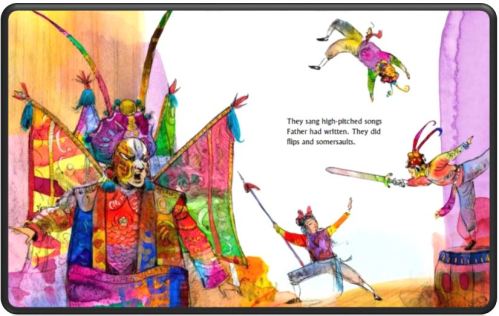
Review
The first thing I noticed about Father’s Chinese Opera was the beautiful illustrations. The watercolor scenes are bright kaleidoscopes of color. The back and fore grounds are washes of orange, blue, green, and reddish-purple. The Chinese opera comes alive on the pages. The young boy, immersed in the opera through his father’s work, wants to be on stage as an acrobat. The famous, and real, Gai Chui agrees to mentor the boy. The acrobatic moves fly around the pages as student and teacher strike identical poses. Father’s Chinese Opera is simply a gorgeous picture book.
The young boy knows he is good. He brags to school friends, and then tells Gai Chui he is ready for his acrobat assignment. Being told he is disrespectful, unqualified, and overconfident the boy sulks, proving Gai Chui correct. I love how the boy’s father, the leader of the Chinese opera, explains to his son why Gai Chui said what he did. The boy wants to start at the top, or near the top, rather than earning his way as others must do. I had no idea a composer, at least for the Chinese opera, must know how to play every instrument. That feat in itself is amazing (and screams picture book story).
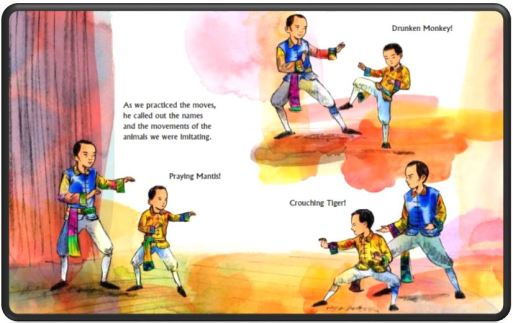
The boy’s indomitable spirit brings him back to the stage, this time as a flag carrier. You can see the joy on his face as he weaves towards the edge of the page. Learning to work your way up to where you want to be is a difficult lesson for a young child. Children live in the here and now, wanting what they want now. Delayed gratification is not a message in the story, but it falls in line with waiting your turn, working your way up, persevering, and keeping a colorfully bright spirit as you work toward that dream.
Children will love Father’s Chinese Opera. It will be a treat for their young eyes. At first, many will think of a circus because of all the color and movement. Boys will connect with the acrobatic moves the young boy learns from Gai Chui, looking at it as karate. It will be up to the reader to explain to the children the story is about a Chinese opera. But those problems are not due to story or art, but rather American culture. Father’s Chinese Opera is a wonderful book for school and classroom libraries.Children need to read about other cultures and Father’s Chinese Opera is a good book to start their journey.
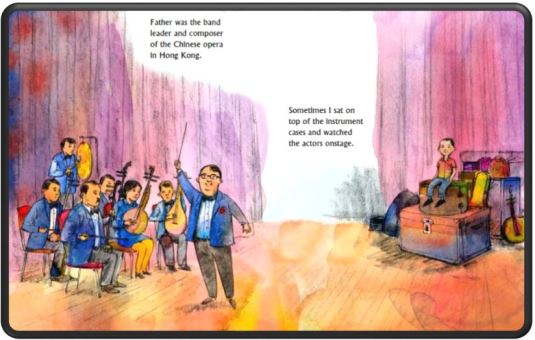
The author’s note explains more about the Chinese opera, his father’s journey, and their move to the U.S. The note is an interesting read and quite informative. Adults will enjoy the author’s life story, though abbreviated. If the author expounded on this note, he would have a captivating memoir.
FATHER’S CHINESE OPERA. Text and illustrations copyright © 2014 by Rich Lo. Reproduced by permission of the publisher, Sly Pony Press, New York, NY.
Purchase Father’s Chinese Opera at Amazon —B&N—Book Depository—Sky Pony Press—your local bookstore.
—B&N—Book Depository—Sky Pony Press—your local bookstore.
.
Learn more about Father’s Chinese Opera HERE.
Meet the author/illustrator, Rich Lo, at his website: http://greatsketch.com/
Find other multicultural books at the Sky Pony Press website: http://www.skyponypress.com/
an imprint of Skyhorse Publishing Inc. http://www.skyhorsepublishing.com/
.

copyright © 2014 by Sue Morris/Kid Lit Reviews
Filed under:
6 Stars TOP BOOK,
Books for Boys,
Children's Books,
Debut Author,
Favorites,
Library Donated Books,
Picture Book,
Top 10 of 2014 Tagged:
acrobats,
actors,
childrens book review,
Chinese Opera,
Father's Chinese Opera,
flag carriers,
picture book,
Rich Lo,
Sky Pony Press,
Skyhorse Publishing Inc. 







By:
Sue Morris,
on 6/23/2014
Blog:
Kid Lit Reviews
(
Login to Add to MyJacketFlap)
JacketFlap tags:
Children's Books,
Picture Book,
freedom,
NonFiction,
Historical Fiction,
Favorites,
slavery,
children's book reviews,
Gretchen Woelfle,
Carolrhoda Books,
Declaration of Independence,
Lerner Publishing Group,
1776,
Alix Delinois,
American Revolutionary War,
Library Donated Books,
6 Stars TOP BOOK,
Top 10 of 2014,
Massachusetts Constitution of 1780,
Add a tag
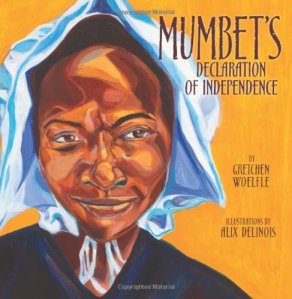 .
.
Mumbet’s Declaration of Independence 
by Gretchen Woelfle & Alix Delinois, illustrator
Carolrhoda Books 2/01/2014
978-0-7613-6589-1
Age 7 to 9 32 pages
.
“All men are born free and equal.” Everybody knows about the Founding Fathers and the Declaration of Independence in 1776. But the founders weren’t the only ones who believed that everyone had a right to freedom. Mumbet, a Massachusetts slave believed it too. She longed o be free, but how? Would anyone help her in her fight for freedom? Could she win against her owner, the richest man in town? Mumbet was determined to try. Mumbet’s Declaration of Independence tells her story for the first time in a picture book biography, and her brave actions set a milestone on the road toward ending slavery in the United States.”
Opening
“Mumbet didn’t have a last name because she was a slave. She didn’t even have an official first name. Folks called her Bett or Betty. Children called her Mom Bett or Mumbet. Others weren’t so kind.”
The Story
The year is 1776 and the United States begins its fight for freedom from the rule of the British by declaring on paper their Declaration of Independence. Mumbet is a slave owned by the richest man in town—the one who is usually the most powerful in town. Colonel John Ashley lived in Massachusetts and owed many businesses. He might have been kind, but his wife was definitely a cruel woman when it came to her husband’s slaves. Mumbet worked for Mrs. Ashley, usually in her kitchen. Mumbet hated that another human owned her, as wouldn’t you or I. She knew servants and hired hands could leave a cruel employer, but Mumbet had no recourse—she’s is property.
As the founding fathers gathered to write the Declaration of Independence, which started the seven-year war against the British, Mumbet served refreshments and tried to listen. The men were against British taxes and feared losing all their rights under British rule. As Mumbet listened, she heard one man say,
“He [the King of England] would make us slaves.”
And,
“Mankind in a state of Nature are equal, free, and independent . . .
God and Nature have made us free.”
After seven years of war against England, and freedom won, the town held a meeting to introduce The Massachusetts Constitution in 1780. It declared,
“All men are born free and equal.”
Mumbet wondered if that meant her. She approached Theodore Sedgwick, a young lawyer who helped draft the Declaration of Independence, and asked him to represent her in a fight for her personal freedom under the new Massachusetts law. He accepted. Mr. Sedgwick reminded the judge and jury that no law existed in Massachusetts making slaves legal and the new constitution now made them illegal. Would the judge and jury agree with Mr. Sedgwick and grant Mumbet her freedom—and the freedom of all slaves in Massachusetts in the process?
Review
Mumbet’s story, a true story, is an unusual biography in that I don’t recall hearing about this woman in any history class, not even American History. Mumbet had strength unseen except on rare occasions. To take your master to court to demand your freedom was a crazy idea. Even white women were still considered their husband’s chattel, why would a slave be above that. How was Mumbet going to convince a jury—not of her peers—and a judge—most likely friends with the richest man in town—that she deserved her freedoms for the same reason as the men deserved theirs from Britain? The new Massachusetts Constitution was not that old and here is this slave trying to gain her freedom, yet she is property. This must have caused some laughter, smirking, and hate. I find this story truly moving. Her new name became Elizabeth Freeman, a most deserved last name.
Mumbet’s clear and succinctly written story tells of an amazing, intelligent, and courageous woman who dared stand up for her rights when no one ever considered her to have rights. She entered a paternal courtroom, a jury not of her peers, and a town overflowing with curious citizens not all of which could have been happy Mumbet wanted freedom. It was probably more hostile, considering ever man probably stood to lose his slaves if Mumbet were successful. That makes Mumbet one of the strongest woman to have ever lived in the United States.
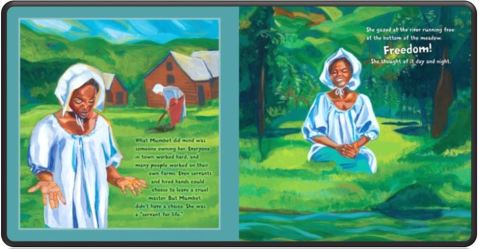
The illustrations are profoundly beautiful with deep rich colors. Even the end pages have an elegance to them. Alix Delinois represented that time in America accurately, with facial expressions that must have matched the frustration felt by most citizens, as the founding fathers wrote the Declaration of Independence. Mrs. Ashley’s cruelty is shockingly visible, immediately making you feel empathy for Mumbet and her daughter. For people sincerely wanting freedom and respect from the British, some were capable of much harm to others.
Thankfully, someone thought to write down Mumbet’s story giving the author great accounts of Mumbet’s life and challenges before, during, and after that day in court. After the story are two pages of author notes. They tell of the help the author received from Catharine Maria Sedgwick, Theodore Sedgwick’s daughter. Catharine wrote Mumbet’s story as it happened, leaving accurate historical documents from which this story was written. These notes are fascinating.Teachers would do well to keep Mumbet’s Declaration of Independence as an adjunct history lesson. It is a story not told in most history classes. Gretchen Woelfle’s impeccable research and storytelling skills gives us a story of slavery not well known in the very country in which it happened—until now. Mumbet’s Declaration of Independence should fascinate kids and adults alike.
MUMBET’S DECLARATION OF INDEPENDENCE. Text copyright © 2014 by Gretchen Woelfle. Illustrations copyright © 2014 by Alix Delinois. Reproduced by permission of the publisher, Carolrhoda Books, Minneapolis, MN.
Buy a copy of Mumbet’s Declaration of Independence at Amazon —B&N—iTunes—Book Depository—Carolrhoda Books—at your local bookstore.
—B&N—iTunes—Book Depository—Carolrhoda Books—at your local bookstore.
.
Learn more about Mumbet’s Declaration of Independence HERE.
Meet the author, Gretchen Woelfle, at her website: http://www.gretchenwoelfle.com/
Meet the illustrator, Alix Delinois, at his website: http://alixdelinois.com/home.html
Find more books a the Carolrhoda Books blog: http://carolrhoda.blogspot.com/
Carolrhoda Books is a division of Lerner Publishing Group, Inc. https://www.lernerbooks.com/
.
Also by Gretchen Woelfle
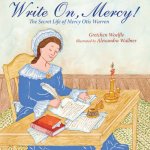
Write On, Mercy!: The Secret Life of Mercy Otis Warren

All the World’s a Stage: A Novel in Five Acts

The Wind at Work: An Activity Guide to Windmills
Also by Alix Delinois
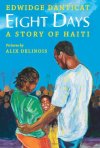
Eight Days: A Story of Haiti
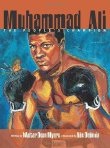
Muhammad Ali: The People’s Champion
.
.

Filed under:
6 Stars TOP BOOK,
Children's Books,
Favorites,
Historical Fiction,
Library Donated Books,
NonFiction,
Picture Book,
Top 10 of 2014 Tagged:
1776,
Alix Delinois,
American Revolutionary War,
Carolrhoda Books,
children's book reviews,
Declaration of Independence,
freedom,
Gretchen Woelfle,
Lerner Publishing Group,
Massachusetts Constitution of 1780,
slavery 







By:
Sue Morris,
on 6/20/2014
Blog:
Kid Lit Reviews
(
Login to Add to MyJacketFlap)
JacketFlap tags:
Children's Books,
Poetry,
NonFiction,
Favorites,
haiku,
children's book reviews,
Millbrook Press,
Brian P. Cleary,
lantern,
Lerner Publishing Group,
Library Donated Books,
6 Stars TOP BOOK,
Top 10 of 2014,
Andy Rowland,
Japanese poetry,
Add a tag
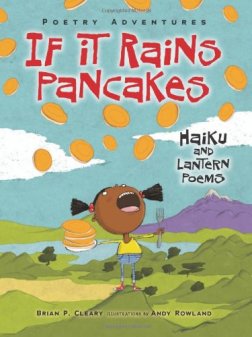 .
.
If It Rains Pancakes: Haiku and Lantern Poems 
by Brian P. Cleary
illustrated by Andy Rowland
Millbrook Press 1/1/2014
978-1-4677-4412-6
Age 7 to 10 32 page
.
“What is a haiku? It sounds like a sneeze. And isn’t a lantern a light source? Actually, they are two types of ancient Japanese poetry. Award-winning author Brian P. Cleary explains how each form works—and shows how these little poems can contain big surprises! If It Rains Pancakes is packed with poems to make you chuckle, puzzle, and ponder. And when you’ve finished reading, you can try your hand at writing your own haiku and lanterns!
“If it rains pancakes,
I’ll need no umbrella, just
syrup, fork, and plate.”
Opening
“Haiku is a short, Japanese form of poetry that has been around for more than four hundred years. That’s much longer than your teacher or your parents have been alive.”
Review
I like books that, even though written for a kid, teaches me something. I know a Haiku has 7 syllables in the first line, then 5 in the next, finishing with 7 in the third and final line. Everyone knows that, right? But, did you know that in Japan syllables are not what matters. Maybe they don’t even have syllables. In Japan, they count sounds and each Haiku has 17 sounds known as on (pronounced a faster than normal “one”). That I did not know, until I read If It Rains Pancakes. Traditionally, haikus are about nature, but Mr. Cleary takes liberties with this and writes Haikus on all sorts of kid-subjects: pets, pizza, and pancakes. I also love something else Mr. Cleary wrote,
“Poetry’s not a spectator sport, so try your hand at this ancient form, and be sure to have fun!”
I love fun as much as I love humor, so here is my haiku.
RAIN
It may rain kittens and pups.
It may rain water.
To be safe, watch where you step.
**I now challenge you to follow Mr. Cleary’s advice and write a haiku or a lantern (see below) in the comment section. I know there are lots of writers, poets, and aspiring writers and poets reading this blog. NOW is the time to show what you have!
Returning to the review: If you don’t like my haiku, Mr. Cleary wrote 20 for you in If It Rains Pancakes. Here are some of the titles, though many will not help you with the subject of the poem. Color Me Confused, City of Brotherly Lunch, The Mind and Yummy. There is one that is helpful to all of us not as poetically inclined as Mr. Cleary is. Kids will want to remember this one for when school resumes—much too soon.
HAIKU
When you’ve written one
without enough syllables,
you add words. Football.
The other half of If It Rains Pancakes is about Lanterns. This is all new to me. A lantern, or lanturne, is also Japanese. This poem has five lines. Line 1 is a 1-syllable noun and the subject of the poem. Line 2 “sheds light” (describes) the subject in two syllables. Line 3 has three syllables, line 4 has four, and line 5 has a 1-syllable word. The poem will look roughly like a lantern, hence the name. Mr. Cleary wrote 15 lanterns, all very cute, most very funny. Since I am a pet person and would have written a lantern about pets, and could not write one better than Mr. Cleary, the example I will share—by Mr. Cleary—is about a pet I know well.
Cat:
“Feed me.”
“Pet me too.”
“Feed me. Pet me.”
“Now.”
The illustrations, which play out the poems, are colorful and as crazy as the poem it represents. If the illustrations do not amuse you, I am lost for words. I love the images that perfectly match each poem. At the end of If It Rains Pancakes is a list of reference books to learn more about haikus and lanterns, and other poems, including one of the author’s, entitled “Rainbow Soup: Adventures in Poetry .” Finally there is a list of websites with more poetry activities, including one I had not heard of—but love the name—called Giggle Poetry at gigglepoetry.com
.” Finally there is a list of websites with more poetry activities, including one I had not heard of—but love the name—called Giggle Poetry at gigglepoetry.com
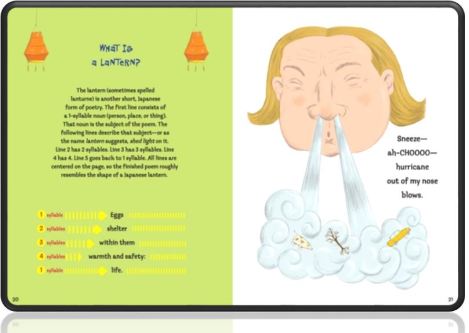
If It Rains Pancakes is a wonderful little book that packs a punch. Teachers would do well to have this on hand when teaching haikus or other Japanese poetry like lanterns. Kids will have fun learning about haikus and lanterns when reading these 35 mostly hilarious poems. Mr. Cleary is a master at teaching kids about writing of every type. If It Rains Pancakes upholds his genius.
IF IT RAINS PANCAKES: HAIKU AND LANTERN POEMS. Text copyright © 2014 by Brian P. Cleary. Illustrations copyright © 2014 by Andy Rowland. Reproduced by permission of the publisher, Millbrook Press, Minneapolis, MN.
Buy a copy of If It Rains Pancakes: Haiku and Lantern Poems at Amazon —B&N—Book Depository—Lerner Books—or your local bookstore.
—B&N—Book Depository—Lerner Books—or your local bookstore.
.
Learn more about If It Rains Pancakes: Haiku and Lantern Poems HERE.
Meet the author, Brian P. Cleary at his website: http://www.brianpcleary.com/
Meet the illustrator, Andy Rowland, at his website: http://andrewrowlandillustration.blogspot.com/
Find more books at the Millbrook Press website:
Millbrook Press is a division of Lerner Publishing Group: https://www.lernerbooks.com/
. .
.
Bookmarks (4) are available free HERE.
Also by Brian P. Cleary in 2014
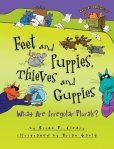
Feet and Puppies, Thieves and Guppies: What Are Irregular Plurals?
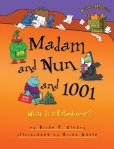
Madam and Nun and 1001: What Is a Palindrome?
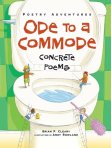
Ode to a Commode: Concrete Poems
-
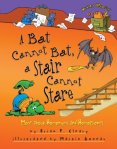
A Bat Cannot Bat, a Stair Cannot Stare: More About Homonyms and Homophones
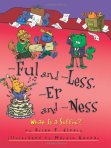
-ful and -less, -er and -ness: What Is a Suffix?
Review HERE
Also by Andy Rowland in 2014

Ode to a Commode: Concrete Poems
The Elves and the Shoemaker (November, 2014)
.
.

**PLEASE DON’T FORGET — SHOW YOUR STUFF! WRITE A HAIKU OR A LANTERN OR REALLY BLOSSOM AND WRITE BOTH IN THE COMMENTS! It is as easy as RAIN.
Filed under:
6 Stars TOP BOOK,
Children's Books,
Favorites,
Library Donated Books,
NonFiction,
Poetry,
Top 10 of 2014 Tagged:
Andy Rowland,
Brian P. Cleary,
children's book reviews,
haiku,
Japanese poetry,
lantern,
Lerner Publishing Group,
Millbrook Press,
poetry 







By:
Sue Morris,
on 5/28/2014
Blog:
Kid Lit Reviews
(
Login to Add to MyJacketFlap)
JacketFlap tags:
Middle Grade,
Series,
Books for Boys,
Debut Author,
Disney-Hyperion Books,
summer camps,
imaginary friends,
Disney Book Group,
Library Donated Books,
6 Stars TOP BOOK,
Top 10 of 2014,
children book reviews,
Clay McLeod Chapman,
mental health in teens and kids,
midde school,
troubled boys,
Add a tag
 .
.
The Tribe #2: Camp Cannibal 
by Clay McLeod Chapman
Disney-Hyperion Books 4/22/2014
978-1-4231-5222-4
Age 8 to 12 322 pages
.
“Since being expelled from giving the Greenfield Middle School student body an “explosive” case of food poisoning and sent to live with his father, Spencer Pendleton hasn’t exactly been doing his best to put the past behind him and settle into his new life. What with losing the girl-of-his-dreams and gaining a there-but-absentee father, his life still has a few kinks to work out. And when his single-minded quest to track down the Tribe and reunite with Sully lands him at Camp New Leaf, Spencer is convinced things can’t get much worse. WRONG!
“Not only is Camp New Leaf no ordinary camp, but it appears that the Tribe hasn’t laid the past to rest either. And what better place to catch up with an old member—or recruit a few new ones—than a secluded camp for “troubled” boys. With rebellion in the air, Spencer must find a way to stop the Tribe’s plans to put down roots and expand its ranks before someone gets seriously hurt—or worse.”
Opening
“Dear Dad . . . If you’re reading this, that can only can one thing:
A. I’m dead and buried somewhere in the woods surrounding Camp New Leaf, my body now a buffet for maggots,
B. I’ve been arrested and am serving a life sentence for crimes I didn’t commit,
C. Me (and my lungs) are on the run.
“You sold me out.”
The Story
Way back in book 1 Spencer meet a group of kids—the Tribe—living secretly in Greenfield Middle School. Not having read the first book—though I really want to—I only know that the Tribe and Spencer had some outs of sort. I think it may have had to do with Sully, a beautiful girl Spencer fell for but another Tribe member, Peashooter, objected for some reason. The Tribe poisoned lunch at the middle school causing the entire student body to have extreme diarrhea. Spencer was to blame, so said the principal and a judge. They asked him to stop blaming his imaginary friends and take responsibility.
Spencer also went to live with his father, who had never been a real father or held up his end of responsibilities, ducking out because of work whenever he was to do something with or for Spencer. With mom now fed up and unsure what to do with Spencer, Dad gets his turn. He continues to skirt his responsibilities and when he gets tired of Spencer’s antics, enrolls him in Camp New Leaf, a summer camp for troubled boys. Not long after arriving at the camp, where many of the campers were returning campers, Spencer felt watched the way the Tribe watched him at his old school. By nightfall, The Tribe had taken control of Camp New Leaf. Spencer got new quarters outside in a makeshift cage, and the youngest campers ran ram shot around the grounds. The Tribe stopped all medication cold turkey—using it on the camp director and his camp counselors. The no medication adjustment period brought out interesting behaviors. Spencer actually thinks clearer when off the medications he never should have been prescribed.
Soon supplies begin to run out and the boys get tired of the Tribe’s rules and “training.” Anarchy prevails just as the parents arrive for Parent’s Day.
Review
Book 2 can stand on its own, but I would not recommend reading it before reading book 1. I think there is one more book to arrive and I would get these two finished before then, whenever “then” is.
The Tribe is interesting, imaginative, and incredibly spellbinding. Imaginary friends, who are not imaginary, but also never seen by anyone but Spencer, live in the middle school. They recruit Spencer, something breaks the bond, the Tribe retaliates, and Spencer catches blame for a horrendous crime committed by the Tribe sans Spencer. In the process he loses his home, the police keep him on a short leash, and then dad sends Spencer away for the summer to a soft therapy camp disguised as a summer camp. But the Tribe are not far away, having lived the past six months in the woods surrounding the camp, which is at least fifty miles from civilization.
Camp Cannibal grabs you immediately and ties to the story. Pages fly by on their own as your gasp at the horrors, laugh at the inane, and wonder if this whole situation were actually possible. Could a summer camp go berserk? The characters standout, nearly every one of them. One dad wants to know what is going on and you can see him standing there, demanding answers with this confused and angry face. You can feel his frustrations and inner horror at what his child is doing and might possibly have become. The Tribe is a wonderful middle grade novel, but one for older kids with more advanced language comprehension and moral compasses.
If you want a story to grab you from page one, to hold you captive just like those at camp, and then free you with a thud as the ending becomes nothing you thought it would, The Tribe is your cup of spiked tea. The ending is shocking, surprising, and most definitely heartbreaking. By the last word you must, absolutely must, read book 3—if only to find out Spencer’s fate. For now, hold your kids tight, tell them you love them, and be available to them every moment they need you and then when they don’t. Be careful. Believe all imaginary friends are real—until they are not.
THE TRIBE #2: CAMP CANNIBAL. Text copyright © 2014 by Clay McLeod Chapman. Reproduced by permission of the publisher, Disney-Hyperion, New York, NY.
Buy The Tribe #2: Camp Cannibal at Amazon —B&N—Disney-Hyperion—your local bookstore.
—B&N—Disney-Hyperion—your local bookstore.
.
Learn more about The Tribe trilogy HERE.
Meet the author, Clay McLeod Chapman, at his website: http://claymcleodchapman.com/
Find more books at the Disney-Hyperion website: http://books.disney.com/
an imprint of Disney Book Group
 The Tribe: Homeroom Headhunters
The Tribe: Homeroom Headhunters
All Schools are the same and Spencer Pendleton expects no less from Greenfield Middle. But Spencer hasn’t met them yet-the Tribe, a group of runaway students who secretly own the school. They live off cafeteria food and wield weapons made out of everyday school supplies. Strangely, no one seems to know they exist, except for Spencer. And the group wants him to join their ranks. All he has to do is pass the initiations…and leave his mother and life behind. Can Spencer go through with it? Better yet, what will happen if he says no?.
.
. 
Filed under:
6 Stars TOP BOOK,
Books for Boys,
Debut Author,
Library Donated Books,
Middle Grade,
Series,
Top 10 of 2014 Tagged:
children book reviews,
Clay McLeod Chapman,
Disney Book Group,
Disney-Hyperion Books,
imaginary friends,
mental health in teens and kids,
midde school,
summer camps,
troubled boys 







By:
Sue Morris,
on 5/21/2014
Blog:
Kid Lit Reviews
(
Login to Add to MyJacketFlap)
JacketFlap tags:
Northwest Passage,
6 Stars TOP BOOK,
Top 10 of 2014,
exploer John Franklin,
Shake-a-Leg Press,
William Fourth,
William Summerhouse,
Children's Books,
Historical Fiction,
Middle Grade,
Series,
children's book reviews,
Books for Boys,
Debut Author,
Arctic,
1847,
Library Donated Books,
Add a tag
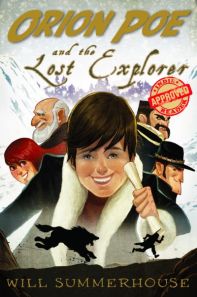 .
.
Orion Poe and the Lost Explorer 
by William Summerhouse
Shake-A-Leg Press 9/14/2014
9780-9860614-0-0
Age 8 to 12 284 pages
.
“Eleven-year-old Orion Poe lives with his stodgy grandfather in eastern Maine, where nothing exciting ever happens. But then a series of strange events draws him into the mystery of the lost explorer and Orion is swept up in a whirlwind of adventure that takes him to the top of the world. To survive he must outwit a scheming treasure hunter, team up with a gang of flimps, and take on a tyrant with an anger management problem. Can Orion solve the mystery and get back home alive? And just what are flimps?”
Opening
“If you read what Mr. Lumpkin wrote in the newspaper about my adventure at the top of the world, you only got half the story.”
The Story
Orion Poe finds a man thrown to the shores of Maine by a nor’easter who turns out to have been running from New Britain, a community at the top of the world. He leaves Orion with a map dated 1847 and written by John Franklin, an explorer looking for the Northwest Passage but disappeared with over 130 men and 2 tall ships. Franklin and his crew were never found.
A John Franklin is the governor of New Britain and a tyrant bent on total control of the inhabitants. He comes searching for the man who Orion found, murders him, and then ransacks Orion’s home looking for the knapsack Orion now has. After taking the map to a professor, the professor and Orion take off on an adventure to find the reason the man washed up on a Maine shore, what he was running from, but mostly, was the map pointing to the lost whereabouts of Franklin and his crew?

Review
Based on the real John Franklin and crew who disappeared and never heard from again, Orion Poe and the Lot Explorer crashes history with adventure in a story difficult to put down. At first, the tall ship looking for the washed up man seemed to be a ghost ship, and it was in its own way, but also a real ship from the 1800’s traveling the current seas. Once at the top of the Canadian Arctic, time stopped for Franklin and his crew and he wanted no one to find out. This once amicable group now lived in tyranny and fear. With the professor and Orion making their way up to the arctic, Franklin’s fears become a reality.
I liked the high seas fighting that occurs and that the real travel times are observed. Orion doesn’t make it to New Britain over night but must face the rough unforgiving sea first. Once there, Orion spends time in the new city and we learn how they could pull off living in such an extreme environment and what year they believe it is: 2013 or 1847. There is also a darker side to this community where the entire group of cast offs are placed. Here a group of courageous kids is quietly fighting the tyranny of New Britain. This side story become important and is some of the best writing.
The edition I received has the author name of William Fourth. I am not sure why this was changed or when, but the real author name is William Summerhouse and many of the books list him as the author. I’m curious as to the change. Throughout the writing is crisp and clean. While reading, it felt like I was right there alongside Orion. Orion Poe and the Lost Explorer, book 1 in the Orion Poe Adventure Series, is Summerhouses debut and it will be rather difficult for him to exceed the story of Orion. Wonderful first start by a promising young writer. Good fun for kids who love fantasy, historical fiction, and most importantly, the mash up of the two genres.
ORION POE AND THE LOST EXPLORER. Text copyright © 2013 by William Summerhouse. Book copyright © 2013 by Shake-A-Leg Press.
Buy Orion Poe and the Lost Explorer at Amazon —B&N—your local bookstore.
—B&N—your local bookstore.
Learn more about Orion Poe and the Lost Explorer HERE.
Book Giveaway! Enter to win HERE.
Meet the author, William Summerhouse, at his website: http://www.willsummerhouse.com/
.
.

Filed under:
6 Stars TOP BOOK,
Books for Boys,
Children's Books,
Debut Author,
Historical Fiction,
Library Donated Books,
Middle Grade,
Series,
Top 10 of 2014 Tagged:
1847,
Arctic,
children's book reviews,
exploer John Franklin,
Northwest Passage,
Shake-a-Leg Press,
William Fourth,
William Summerhouse 







By:
Sue Morris,
on 5/6/2014
Blog:
Kid Lit Reviews
(
Login to Add to MyJacketFlap)
JacketFlap tags:
Babe Ruth,
Tundra Books,
Zachary Pullen,
New York Yankees,
Top 10 of 2014,
Zachary Hyman,
George Herman Ruth,
The Bambino,
Children's Books,
Favorites,
Books for Boys,
Library Donated Books,
6 Stars TOP BOOK,
Picture Book,
baseball,
Middle Grade,
children's book reviews,
Boston Red Sox,
Add a tag
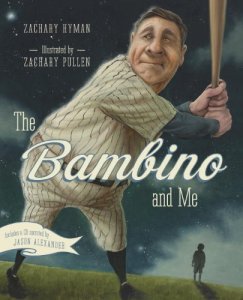 .
.
The Bambino and Me
by Zachary Hyman & Zachary Pullen, illustrator
Tundra Books 4/1/2014
978-1-77049-627-9
Age 6 to 9 50 pages
.
“It’s 1927, and ten-year-old George Henry Alexander is full of the joys of summer: long days, warm nights, and baseball, especially the greatest player in the game: Babe Ruth—the Bambino. When George’s parents surprise him with tickets to a game between his beloved Yankees and their rivals, the Boston Red Sox, he couldn’t be more excited. A real baseball game, and his first chance to see his hero in the flesh. But when the big day arrives, things don’t quite go according to plan. On what is supposed to be the best afternoon of his young life, George finds himself doing the one thing no true Yankees fan should ever do. He’s so low he’d rather kiss a girl! How can he face his hero when he feels like the biggest traitor in the world?”
Opening
“I’ll always remember the summer of 1927. I was ten, and we lived in a tiny apartment above Berman’s Bakery in the Bronx.”
The Story
Ten-year-old George Henry loved baseball. He doesn’t play the game very well and is often the last picked for a team, but George loves baseball just the same. To George, the best team in the world is the New York Yankees and the best player is Babe Ruth—the Bambino. For George’s birthday, his parents give him tickets to a Yankee home game against the Boston Red Sox, the big rival. George also gets a gift from his Uncle Alvin, who lives in Boston. He sends George a baseball cap and a jersey—for the Red Sox! George cannot wear a Boston Red Sox jersey, he’ll be a traitor, but mom insists George will wear them—else he will insult his Uncle. On game day, with his proud pop wearing a Yankee blue tie, poor George goes to the game of his life wearing a Boston Red Sox jersey. George stands out at the game, being the only one in red sitting in a sea of blue in the home-side stands. How can he enjoy the game when he is being a traitor to the Yankees and his hero?
Review
Obviously, neither mom nor Uncle Alvin understand iota about the game of baseball, the New York Yankees, or rivalries. George stands up to mom the best he can. I was hoping maybe pop would have a change of clothing for his son, or get him a jersey at the game, but nope, poor George sits through the entire game looking like a Red Sox fan. It’s criminal.
Baseball stories are terrific and ones about Babe Ruth even better—if they are well written. The Bambino and Me is a home run! I like the story from a young fan’s point of view that explains how rabid fans can become. Little George doesn’t mouth off to his mom, but the day she insists he will wear the Red Sox jersey, he fought the best he could and goes farther against his Mom than he probably ever thought he would. So far, in fact, that the soap bar punishment falls upon George. Mom just does not get it, which is why little girls are not in baseball stories from the 1920’s.
The illustrations are great. You are pulled back to that earlier time in New York City when men wore suits and ties to baseball games. When kids played outside without a phone and read real books. People’s faces look gummy due to the intricate detail of the face. When Mom yells, her second chin tries to come forth and every muscle around her mouth is visible through the cheek. Understanding the expression on any character’s face is an easy read. Once in the Red Sox uniform, George looks like a tiny man rather than a boy, which is humorous, and I hope this is the intent. The illustrations can tell the story, making this a good choice for story hour or reading to a group of different aged kids. I wish I could have shown you the standard three spreads. Tundra has a policy of one spread, but it is a terrific spread. You can see the mushy faces that bring out the nostalgia of the era.
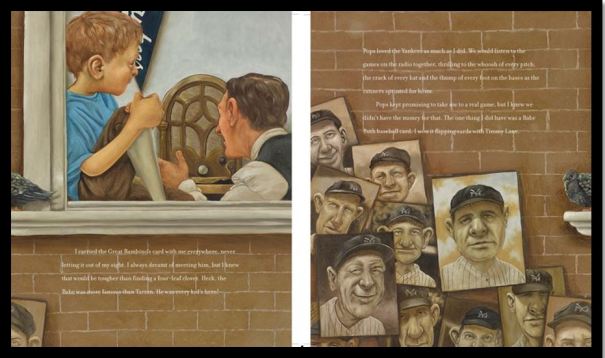
I love the illustrations of the stands where poor George has a horrible time in the Red Sox uniform surrounded by blue on all sides. Some of the other fans, including adults, give George looks that run from nasty to shock to humor. The text will keep you reading, wanting to know how this horrible outing will turn around for George. Of course, Babe Ruth spots him. “Two palookas” escort George and his father under the stadium where a scene unfolds that every baseball fan, young and old, would give most anything to have happen. As wonderful as the illustrations are, without the text you miss the “two palookas” and the message Babe Ruth writes on George’s baseball card
After the story, the author, a young* Zachary Hyman, gives the reader insight into why he wrote the book. There are also actual pictures from Babe Ruth’s playing days peppered in with the illustrations. If you do not feel like reading, but want to know how things turn out for little George, (big George is George Herman Ruth—Babe Ruth, the Bambino), you can listen. Jason Alexander, who played another “George” in Seinfeld, will read you the story, just pop in the included CD.If that isn’t enough, take off the book jack and turn it inside out. You will have a nice poster of Babe Ruth and one of his iconic quotes.
Young boys and girls will like this story about a young boy named George forced to be a traitor to his hero, and the hero’s response. The story is about doing you best; being your best; giving it—whatever “it” means to you—your all every time and, according to Babe Ruth, success will follow. While the story is fiction, it is not far-fetched, considering Babe Ruth’s love of children. One wonders, if George had not worn Boston red, and therefore never having stood out to Babe Ruth, would he have met his idol. Maybe Uncle Alvin did know a little about baseball after all.
*Zachary Hyman is a University of Michigan student. This year, as a Junior, Zach (ice hockey, #11), won the Bates/Deskins Award—Awarded annually by UofM to a junior student-athlete who excels both academically and athletically. I am an Ohio State Buckeye, but given the prestige of the award, I heartily say, “Congratulations, Zach!”
THE BAMBINO AND ME. Text copyright © 2014 by Zachary Hyman. Illustrations copyright © 2014 by Zachary Pullen. Reproduced by permission of Tundra Books, Toronto, ON.
Learn more about The Bambino and Me HERE.
Buy The Bambino and Me at Amazon—B&N—Tundra Books—your local bookstore.
.twitter site
Meet the author, Zachary Hyman at his twitter site: https://twitter.com/ZachHyman
Meet the Illustrator, Zachary Pullen at his website: http://www.zacharypullen.com/
Find more books at the Tundra Books website: http://www.tundrabooks.com/
Thank you to Mr. Dan Sharpe of Random House for the illustration.
.
Also by Zachary Hyman
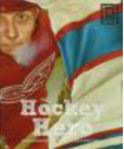
Hockey Hero.
.
.
.
Also by Zachary Pullen
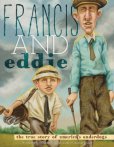
Francis and Eddie, the True Story of America’s Underdogs
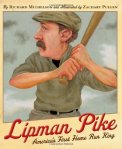
Lipman Pike: America’s First Home Run King
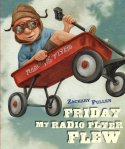
Friday My Radio Flyer Flew
.
.

Filed under:
6 Stars TOP BOOK,
Books for Boys,
Children's Books,
Favorites,
Library Donated Books,
Middle Grade,
Picture Book,
Top 10 of 2014 Tagged:
Babe Ruth,
baseball,
Boston Red Sox,
children's book reviews,
George Herman Ruth,
New York Yankees,
The Bambino,
Tundra Books,
Zachary Hyman,
Zachary Pullen 







By:
Sue Morris,
on 4/5/2014
Blog:
Kid Lit Reviews
(
Login to Add to MyJacketFlap)
JacketFlap tags:
Nina Laden,
zoo animals,
Library Donated Books,
6 Stars TOP BOOK,
Top 10 of 2014,
peek-a-boo,
Children's Books,
Favorites,
Chronicle Books,
Board Books,
Add a tag
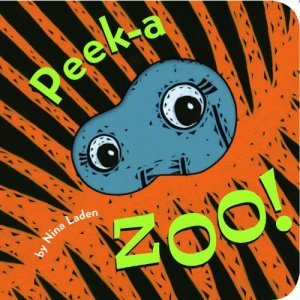 .
.
Peek-A-Zoo!
by Nina Laden
Chronicle Books 2014
978-1-4521-1175-9
Age 0 to 3 20pages
.
“Peek-a mew? Peek-a ‘roo? Peek-a zoo! In this hilarious follow-up to the bestselling board book Peek-a Who, Nina Laden turns her playful eye (and ear) to the animal world. Read the clue . . . guess the animal . . . giggle wildly . . . and repeat!”
Review
Peek-a Zoo. What can I say about this interesting board book? First, when you even open it, you see a pair of eyes encased in blue. What in the world could this be? Check real close. The eyes have long eyelashes. Below the eyes would be a nose, but instead, there are two lines down that have lines moving horizontally from the first line to the second. This cannot be a nose, so what is it? The one big clue is this . . . “Zoo.” It has to be an animal. A blue animal? Well, I give up. I am turning the page . . . oh, my, gosh! It is an elephant! No, not just an elephant, but a kangaroo, a panda, a tiger, and a cockatoo, too.
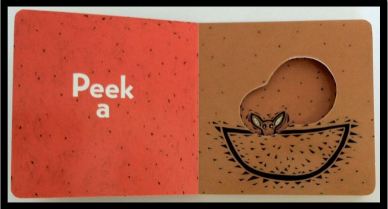
Now there is nothing left to do but turn the thick, baby-safe pages and find out what is next in this Peek-a Zoo. The page is orange with black stripes. Maybe it is black with orange stripes. There is also a stripe of orange running down the middle that looks more like a river. What animal has a river of orange running down the middle of . . . what? Its face, its arm, its back, its stomach? Do you know? Me either. I’m turning the page. Whoa! It could be an orange kitty playing with a ball of yarn or a baby tiger. Look at the eyes! They are green and look maniacal. Look at the ears; they are round, not pointy like most kitties. I think this is a baby tiger!
Time to turn the page again. Then again, and again. Each new set of two pages has a new zoo animal for you and your child to guess. Add some ferocious sounds and you will have your child roaring along in laughter. I’ve not seen the first by Nina Laden, titled Peek-a Who, but if it is anything like Peek-a Zoo, I understand why it was a bestseller.
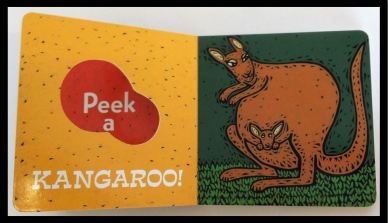
The illustrations are bright, colorful images kids will instantly recognize. Plus, little ones love animals. I think one reason they like animals is because it gives mom or dad, grandma or grandpa, aunt or uncle, or maybe even big brother or sister, the opportunity to not only read the book, but to add voices as well. Animal voices. What could be better than that? “Roooaar!” How about each page having an “oo” sound one might find in a z-oo, as in a kangar-oo, bamb-oo, and cockat-oo. The “oo” sound is one of those that you can elongate and exaggerate, which is usually good for a smile, if not a laugh. One word of caution: be careful of the last animal, it is the most ferocious of them all.
PEEK-A ZOO! Text and illustrations copyright © 2014 by Nina Laden. Reproduced by permission of the publisher, Chronicle Books, San Francisco, CA.
.
Learn more about Peek-a Zoo Here.
Buy Peek-a Zoo at Amazon—B&N—Chronicle Books—your local bookstore.
.
Meet the author / illustrator, Nina Laden, at her website: http://www.ninaladen.com/
Find more wonderful board books at the Chronicle Books website: https://www.chroniclebooks.com/
.
Also by Nina Laden

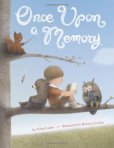
Once Upon a Memory .
.
.
.
.
.
.
Also by Chronicle Books

We’re Going to the Farmers’ Market
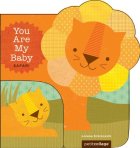
You Are My Baby: Safari
.
.
.
.
.
.
.
 .
.
Filed under:
6 Stars TOP BOOK,
Board Books,
Children's Books,
Favorites,
Library Donated Books,
Top 10 of 2014 Tagged:
Chronicle Books,
Nina Laden,
peek-a-boo,
zoo animals 







By:
Sue Morris,
on 4/2/2014
Blog:
Kid Lit Reviews
(
Login to Add to MyJacketFlap)
JacketFlap tags:
children's book reviews,
Peachtree Publishers,
grudges,
Eliza Wheeler,
Mara Rockliff,
Library Donated Books,
6 Stars TOP BOOK,
Top 10 of 2014,
spats,
tiffs,
Children's Books,
forgiveness,
Picture Book,
Favorites,
Add a tag
 .
.
The Grudge Keeper
by Mara Rockliff & Eliza Wheeler
Peachtree Publishers 4/1/2014
978-1-56145-729-8
Age 4 to 8 32 pages
.
“No one in the town of Bonnyripple ever kept a grudge. No one, that is, except old Cornelius the Grudge Keeper. Ruffled feathers, petty snits, minor tiffs, and major huffs, insults, umbrage, squabbles, dust-ups, and imbroglios—the Grudge Keeper received them all, large and small, tucking each one carefully away in his ramshackle cottage. But when a storm flings the people together and their grudges to the wind, will the Grudge Keeper be out of a job?”
Opening
“No one in the town of Bonnyripple ever kept a grudge. No one, that is, except old Cornelius the Grudge Keeper.”
The Story
The citizens of Bonnyripple do not hold grudges. Nope, not one grudge. Anyone new to town would wonder how everyone kept from holding a grudge. They all had Cornelius. Elvira ran a grudge up to Cornelius against the darned goat—the one that supped on her prize zinnias—and Cornelius has held that grudge for her ever since. All the townsfolk run their grudges up to Cornelius and then go about their happy lives. Poor Cornelius was so inundated with grudges his house could find little room for more, yet more came.
Sylvester loves to prank his schoolmaster. One day he plucked the man’s toupee right off his baldhead. The schoolmaster took great offense to this . . . but he never held a grudge against Sylvester, no matter how many times Sylvester pranked the man. A huge storm came in with gusty winds strong enough to knock Minnie’s fresh-made lemon pie off the windowsill, where it had sat cooling off. That pie landed right on top of Elvira’s cat, surely bringing home a mess.

The moment the winds died down and the sun once again shined upon the people of Bonnyripple, Elvira walked up to Cornelius, ready with her grudge. If she had looked behind herself, she would have seen everyone from town with grudges for Cornelius to store. When the townsfolk made it to Cornelius’s house, they could not believe the sight. Poor Cornelius lay buried beneath a huge pile of decades-old grudges and no way out. Can they get Cornelius out from under the weight of all those grudges before it bears down upon him?
Review
The ending to The Grudge Keeper not only satisfies a wonderful story, it teaches a lesson in civility. The people of Bonnyripple did not like holding a grudge, but a grudge unsatisfied will always be a grudge. Therefore, they gave the grudge to someone else to handle—Cornelius. Eventually, those grudges landed everywhere, thanks to a storm, but Cornelius was nowhere. What the townspeople did next would change the entire atmosphere of Bonnyripple.
Younger children, without help from an adult, may not understand this picture book. At age four, kids do not know what a grudge is even if they have heard the word. They do understand how to apologize and to forgive. By age six or seven, kids understand what holding a grudge means and may hold one or two themselves. If only the people of Bonnyripple had known how to say, “I’m sorry” and “I forgive you.”

Reading The Grudge Keeper was easy, without a tongue tie-up from start to finished, no matter how hard the word or the wind swirled around Bonnyripple. The writing uses word play and humor, even in the naming of characters. I love the way the author describes action.
“Laundry fluttered on the line. Lily Belle’s best flowered bonnet skipped away. Big Otto captured it and brought it back, but Lily Belle just grumbled that the petals were all out of place.”
The illustrations seem perfect for the story, as if both text and illustrations were completed side-by-side. With its sophisticated look, parents will appreciate The Grudge Keeper as much as, if not more than, their children. Kids will love the oft-comical illustrations.
Every wrong is a grudge to the townsfolk and you can see this in their eyes and in their postures. How do you settle a grudge? No revenge is needed, only a simple and heartfelt apology and forgiveness. Will the people of Bonnyripple ever understand this? If they do—or don’t—what will they and their town become?

THE GRUDGE KEEPER. Text copyright © 2014 by Mara Rockliff. Illustrations copyright © 2014 by Eliza Wheeler. Reproduce by permission of the publisher, Peachtree Publishers, Atlanta, GA.
.
Learn more about The Grudge Keeper HERE.
Buy The Grudge Keeper at Amazon—B&N—Peachtree Publishing—your local bookstore.
.
Meet the author, Mara Rockliff, at her website: http://mararockliff.com/
Meet the illustrator, Eliza Wheeler, at her website: http://wheelerstudio.com/
Find more great books at the Peachtree Publisher website: http://peachtree-online.com/
.
Also by Mara Rockliff

Me and Momma and Big John

My Heart Will Not Sit Down
.
.
.
.
.
Also by Elia Wheeler

Miss Maple’s Seeds

Doll Bones
.
.
.
.
.
.New at Peachtree Publisher

Beneath the Son

Claude at the Beach
.
.
.
.
.
.Read a shortened version of The Grudge Keeper‘s journey from manuscript to publication HERE.

Peachtree Book Blog Tour
The Grudge Keeper
Monday
A Word’s Worth
Tuesday
Reading to Know
Wednesday
Chat with Vera
Thursday
Tolivers to Texas
Kid Lit Reviews You Made it Here! Now Please Check Out the Others.
Friday
Geo Librarian
Filed under:
6 Stars TOP BOOK,
Children's Books,
Favorites,
Library Donated Books,
Picture Book,
Top 10 of 2014 Tagged:
children's book reviews,
Eliza Wheeler,
forgiveness,
grudges,
Mara Rockliff,
Peachtree Publishers,
spats,
tiffs 







By:
Sue Morris,
on 3/31/2014
Blog:
Kid Lit Reviews
(
Login to Add to MyJacketFlap)
JacketFlap tags:
Children's Books,
Picture Book,
Favorites,
Candlewick Press,
children's book reviews,
ecology,
judy sierra,
sustainability,
gardens,
matthew Myers,
Library Donated Books,
6 Stars TOP BOOK,
Top 10 of 2014,
eieio,
environmentlism,
old macdonald had a farm,
organic frming,
Add a tag
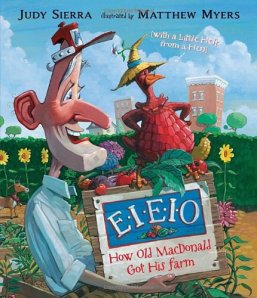 .
.
EIEIO: How Old MacDonald Got His Farm with a Little Help From a Hen
by Judy Sierra & Matthew Myers, illustrator
Candlewick Press 2/25/2014
978-0-7636-6043-7
Age 4 to 8 32 pages
.
“Once upon a time, Old MacDonald didn’t have a farm. He just had a yard—a yard he didn’t want to mow. But then, under the direction of the wise (and ecologically sensitive) Little Red Hen, Mac learns to look at the environment in a very different way, and whole new worlds start to bloom.”
Opening
“Old MacDonald had a house, E-I-E-I-O!”
The Story
Old MacDonald had a house with a big backyard he didn’t like to mow. In fact, he waited so long to mow it that Old MacDonald would sweat after just a short push of his power mower. There had to be a better way. So Old MacDonald got a goat. E-I-E-I-O! There were problems with the goat. MacDonald knew there had to be a better way, so he searched the Internet for help. He got that help from the Little Red Hen, the smartest hen in the world. But could she help Old MacDonald with his backyard lawn mowing aversion?
Review
A fun story that will have kids and adults laughing from the beginning, E-I-E-I-O puts Old MacDonald in the middle of suburbia. He has a house with a large backyard and Old MacDonald doesn’t like to mow. He gets a goat but the goat eats the hedges, putting a window between MacDonald and his neighbor. But MacDonald’s real trouble—and fame—doesn’t begin until he hires the Little Red Hen. I love bringing in a character from another story. It adds more flavor to the story and most kids will instantly recognize the Little Red Hen. Plus, this wise hen has an agricultural diploma—perfect for Old MacDonald.
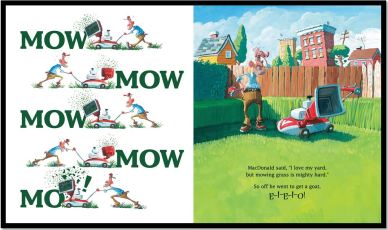
First, Little Red Hen gets rid of the grass. At first, I didn’t get what she was doing—nor will most kids—but soon it became clear. Until that could happen, the neighbors join and form a protest, insisting, as one sign put it, “A LAWN in every YARD.” I love the signs. One says the neighbors formed a mud watch group. But the sign stating, “Change is BAD” pretty much sums up the problem: no one like change. Though there is one little guy who may like change. His sign says, “No More Mud,” but he put a line through one of those words. Not until Old MacDonald has a workable farm, producing organic veggies, does the neighborhood change their feelings toward the smell of Old MacDonald’s backyard farm.
The illustrations are fantastic. They tell the story as well as the text tells it. The details are terrific and sometimes surprising, but you must look carefully to appreciate all the effort that went into these spreads. Colorful, informative, and humorous are but three words that immediately come to mind when looking at E-I-E-I-O. I love the part when Little Red Hen has Old MacDonald throw his trash onto his backyard, well, actually, his back-mud. Old MacDonald looks like he has given up when he tosses his corncob out the window onto his back-mud.
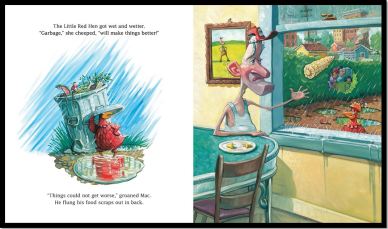
Kids inherently think the word “poop” is funny. Well, Little Red Hen cannot make her compost without it, or worms, so kids will love these spreads. Of course, Little Red Hen stays out of the muck, calling directions out from atop her hen house. Yes, she is one wise hen. Eventually, Old MacDonald gains the neighbors’ favor and a new career in one of the most entertaining, yet informative, picture books this year.
E-I-E-I-O: HOW OLD MACDONALD GOT HIS FARM. Text copyright © 2014 by Judy Sierra. Illustrations copyright © 2014 by Matthew Myers. Reproduced by permission of the publisher, Candlewick Press, Somerville, MA.
E-I-E-I-O- POSTER
Learn more about E-I-E-I-O: How Old MacDonald Got His Farm with a Little Help From a Hen HERE.
Get your copy of E-I-E-I-O at Amazon—B&N—Candlewick Press—your local bookstore.
.Meet the author, Judy Sierra at her website: http://www.judysierra.net/
Meet the illustrator, Matthew Myers at his website: http://www.myerspaints.com/
Find other great books at Candlewick Press’ website: http://www.candlewick.com/
Also by Judy Sierra
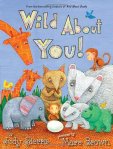
Wild About You!
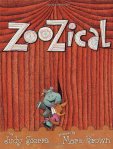
ZooZical

Suppose You Meet a Dinosaur
.
.
.
.
Also by Matthew Myers
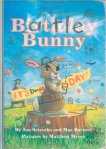
Battle Bunny
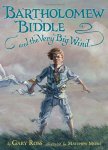
Bartholomew Biddle and the Very Big Wind

The World According to Musk Ox 9/2014
.
.
.
.
.
.New from Candlewick Press

Ocean Creatures: A 3D Pocket Guide

FETCH! with Ruff Ruffman: Doggie Duties
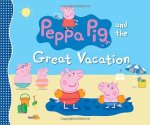
Peppa Pig and the Great Vacation
.
.

Filed under:
6 Stars TOP BOOK,
Children's Books,
Favorites,
Library Donated Books,
Picture Book,
Top 10 of 2014 Tagged:
Candlewick Press,
children's book reviews,
ecology,
eieio,
environmentlism,
gardens,
judy sierra,
matthew Myers,
old macdonald had a farm,
organic frming,
sustainability 







By:
Sue Morris,
on 3/28/2014
Blog:
Kid Lit Reviews
(
Login to Add to MyJacketFlap)
JacketFlap tags:
Children's Books,
Picture Book,
NonFiction,
Favorites,
children's book reviews,
English language,
sentence structure,
Vanita Oelschlager,
Library Donated Books,
vanita books,
language arts for kids,
6 Stars TOP BOOK,
Top 10 of 2014,
dangling participles,
Mike DeSantis,
Add a tag
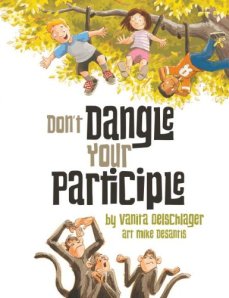 .
.
Don’t Dangle Your Participle
by Vanita Oelschlager & Mike DeSantis, illustrator
Vanita Books 5/01/2014
978-1-938164-02-6
Age 4 to 8 24 pages
.
“Words and pictures show children what a dangling participle is all about. Young readers are shown an incorrect sentence that has in it a dangling participle. They are then taught how to make the sentence read correctly. It is done in a cute and humorous way. The dangling participle loses its way and the children learn how to help it find its way back to the correct spot in the sentence. This is followed by some comical examples of sentences with dangling participles and their funny illustrations, followed by an illustration of the corrected sentence. Young readers will have fun recognizing this problem in sentence construction and learning how to fix it.”
Opening
“What on earth is a participle and how does it dangle? Okay. Okay. Let’s start from the beginning.”
Review
In Don’t Dangle Your Participle Vanita explains what a dangling participle is and explains how to fix the sentence so that the participle no longer dangles and mangles the sentence’s meaning. The participle comes before the noun to clarify it, but Vanita shows how easy it is for the modifier to get lost, ending up in the wrong place in the sentence. If you still don’t get it from that explanation, well, this is because explanations are easier to understand when Vanita adds in pictures to make her point.
And it works!
I know this because dangling participles (and dangling modifiers, but that is another story) have always confused me, BUT honest, after reading Don’t Dangle Your Participle, I understand what a dangling participle is and how to correct the sentence and send the raskly participle on its way to bother someone else’s sentence. Don’t Dangle Your Participle belongs in every school library and language arts classrooms. Using humorous illustrations, Vanita shows how the participle, when left to dangle, changes the meaning of the sentences often with disastrous consequences. Try this one.
- While riding his skateboard in the park, a deer almost ran into Lester.
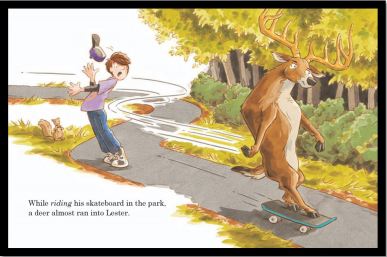
What this sentence is saying is this: When the deer rode his skateboard in the park, it almost ran into Lester. This is not what the sentence was supposed to mean. The dangling Participle—riding—changed the meaning of the sentence to something unintended and, as shown by the illustration, often something unintentionally funny. Vanita clearly shows kids how to fix these sentences.
Did you get the correct sentence? Maybe another illustration will help.
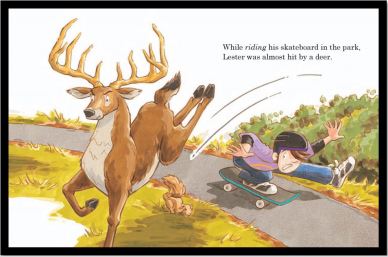
Correct: While riding his skateboard in the park, Lester was almost hit by a deer.
Vanita has a canny way of helping kids understand English and its many rules. She effectively uses humor, which can help a child remember a concept. The more senses involved in learning, the better the material will be remembered. Vanita easily explains a subject, breaking it down so that kids can get the concept quickly. Don’t Dangle Your Participle may be her best language arts book yet.
Don’t Dangle Your Participle can help teachers explain sentence structure in general and the dangling participle. Many of Vanita’s books make great adjunct texts, especially in a homeschooling situation. For those kids that like to learn, Vanita Books make learning loads of fun. Don’t Dangle Your Participle helps the teacher and student, and charitable organizations—all net profits go to select charities. Try one more. Are you ready?
- Melting in the hot sun, Ida rushed to finish her ice cream.

This sentence says, As Ida was melting, she rushed to finish her ice cream. The dangling participle—melting—changed the meaning of this sentence. The writer is trying to say, the ice cream was melting, but darn it, he dangled the participle!
I bet you figured out the correct sentence. Just in case, here it is with a visual aide.

Correct: Melting in the hot sun, the ice cream had to be finished quickly
English is a difficult language. The rules are numerous and onerous. Kids need all the help they can get in understanding how to write English. Don’t Dangle Your Participle can be that help and should be available to every school child by way of the classroom and the library. Vanita explains the participle—a verb that acts like an adjective—and what happens when the participle no longer comes before the proper noun—it dangles. Her use of fun and funny illustrations help drive home her explanations. If I can finally understand these dangerous dangling participles, kids will be able to and probably faster. Use Don’t Dangle Your Participle can be used at home and at school to increase your child’s ability to write English properly. A skill that will help children their entire life.
.
Learn more about Don’t Dangle Your Participle HERE.
Buy Don’t Dangle Your Participle at Amazon—B&N—Vanita Books—your local bookstore.
.
Meet the author, Vanita Oelschlager at her website: http://vanitabooks.com/MeetVanita.html
Meet the illustrator, Mike DeSantis at his website: http://www.mikedesantis.com/picblog/
Find more wonderful Vanita Books at the publisher’s website: http://vanitabooks.com/index.html
.
DON’T DANGLE YOUR PARTICIPLE. Text copyright © 2014 by Vanita Oelschlager. Illustrations copyright © 014 by Mike DeSantis. Reproduced by permission of the publisher, Vanita Books, Akron, OH.
. ALSO BY VANITA BOOKS
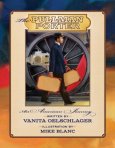
The Pullman Porter

Knees
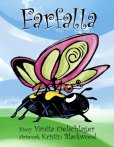
Farfalla
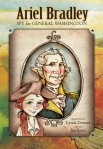
Ariel Bradley
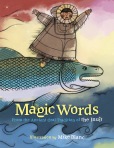
Magic Words
.
.
Reviews: The Pullmn Porter–Knees–Farfalla–Ariel Bradley–Magic Words

Filed under:
6 Stars TOP BOOK,
Children's Books,
Favorites,
Library Donated Books,
NonFiction,
Picture Book,
Top 10 of 2014 Tagged:
children's book reviews,
dangling participles,
English language,
language arts for kids,
Mike DeSantis,
sentence structure,
vanita books,
Vanita Oelschlager 







By:
Sue Morris,
on 3/9/2014
Blog:
Kid Lit Reviews
(
Login to Add to MyJacketFlap)
JacketFlap tags:
Civil rights movement,
Mike Blanc,
Vanita Oelschlager,
Library Donated Books,
vanita books,
6 Stars TOP BOOK,
Top 10 of 2014,
George Pullman,
Pullman Porters,
Children's Books,
Picture Book,
NonFiction,
Middle Grade,
children's book reviews,
Civil War,
Add a tag
 .
.
The Pullman Porter: An American Journey
by Vanita Oelschlager & Mike Blanc
Vanita Books, Inc.** 2/01/2014
978-1-938164-00-2
Age 7 to 12 42 pages
.
Back Cover
“Children and adults under the age of 40 are forgetting about the Pullma Porter. They were very important figures in the history of America. This book will teach children and adults who the porters were and why they were so important in our history. Porters worked in early train cars, they would look, listen and learn from their predominantly white passengers. They would read the newspapers passengers left behind, listen to conversations and begin to talk to one another. The Porter learned how important education was for children and how important it was to take this message home to his children. He eventually landed at the forefront of the civil rights movement”
Opening
“Who was the most important African-American in the 100 years following the end of the Civil War in 1865?”
About
Railroads came to be important ways to travel in early America, starting with its inception in 1830. The ride was not accommodating. Travelers were uncomfortable and dirty, and ate only if they brought their own food. George Pullman changed all that. He built The Pullman Sleeping Car. It had fancy sleeping and dining cars. Those who could afford it ate fine meals and slept on mattresses dressed in fine linens. Pullman heated the trains and put in lights (candlelight).
The Civil War freed slaves and Pullman hired the best and smartest to work as train porters. Porters had numerous jobs; from maid to shoeshine boy, and both nurse and nursemaid. Porters carried rulebooks that spelled out how to handle every possible situation they could encounter, but their main role was making beds at night and turning them back into seats the next day. A passenger could fall out of bed, tossed by the train, if the porter made the bed incorrectly.
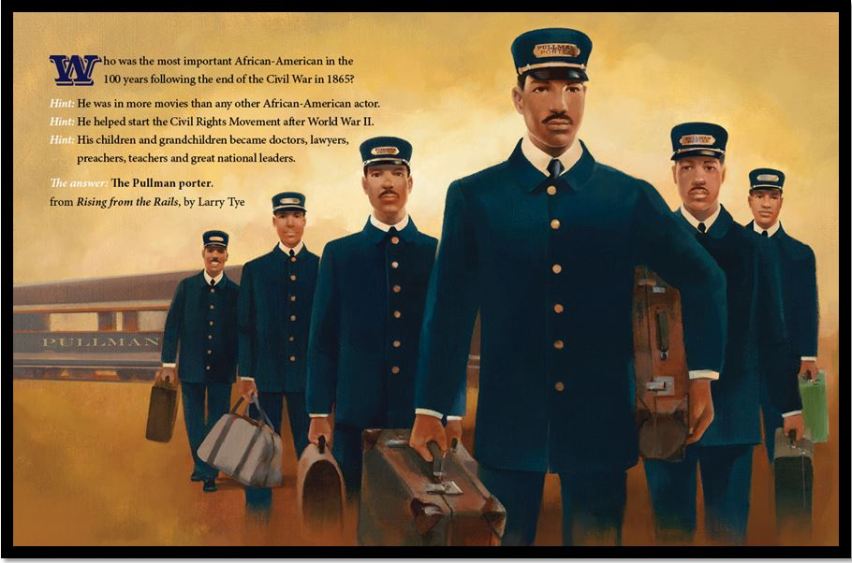
A porter’s appearance had to be “porter-perfect,” including the uniforms, which they had to buy. Porters earned little, depending more on tips earned by giving extra attention to, and doing extra things for, the customer. Most riders simply called the porters “George” after Mr. Pullman. Rarely did they bother to learn a porter’s real name. Pullman Porters worked 240 hours a month for as little as $10.
By 1925, the porters began unionizing, thanks to A. Philip Randolph, another porter. Twelve years later, in 1937 the union, The Brotherhood of Sleeping Car Porters, became reality. Better wages and working conditions were the result. In 1956, Pullman Porters held the Montgomery Bus Boycott, starting the civil rights movement. A. Philip Randolph introduced Martin Luther King at the Washington rally on August 28, 1963 and gave Mr. King the reigns to the civil rights movement. It was a porter, E. D. Nixon, who asked Rosa Parks to refuse a seat in the back of the bus.
By late 1960, Americans preferred to travel by airplane and the Pullman Porters began fading out. Pullman porters are important to America’s history. They struggled for equal rights, civil rights, and helped the exploration and settlement of the United States.
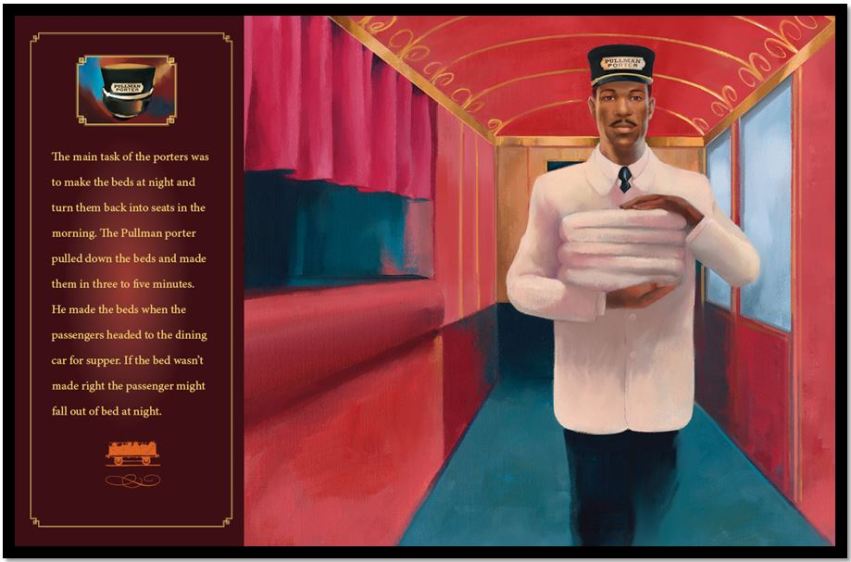
Review
The Pullman Porter: An American Journey tells the story of the Pullman Porters who worked hard making train travel comfortable for Americans exploring the United States. The book is a comfortable weight, with thick cream pages border in brown. The digitally finished paintings together became a book of realistic illustrations. Every page is a brown tone. The porters are meticulous in appearance.
The text is long for a picture book. Most young children will not sit through the story, but many would love the illustrations. The Pullman Porter makes a great elementary adjunct textbook. It seems Ms. Oelschlager did not leave any details out of her book. Elementary kids will learn this history thanks to the straightforward text and the realistic and engaging illustrations. Teachers can utilize The Pullman Porter in classroom discussions of the American West, early train transportation, the civil rights movement, and the early freedom of the African-American. The Pullman Porter, not being a dry textbook, will hold children’s attention and help them remember the lesson.
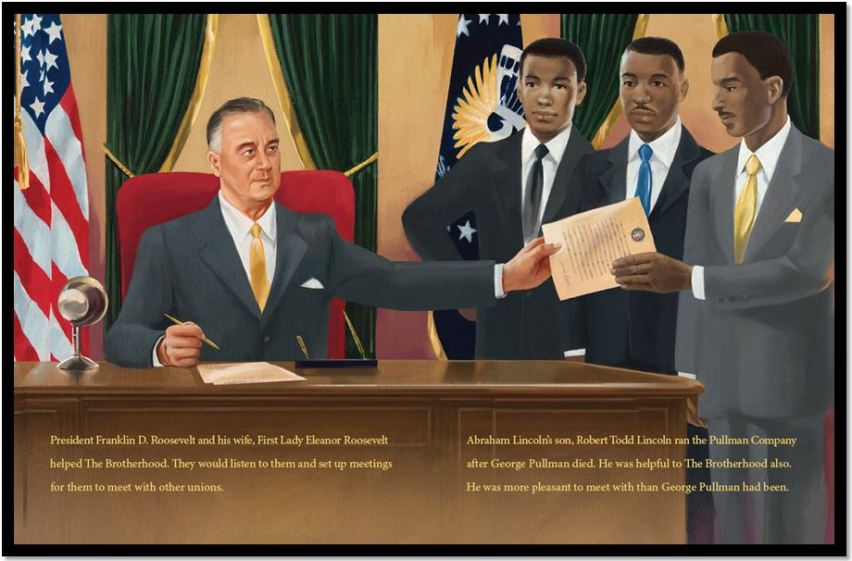
I like The Pullman Porter and was instantly attracted to the cover. Inside are many little bits of information a normal textbook will not tell you. Things like Whoopi Goldberg and Thurgood Marshall being descendants of Pullman porters. The porters being the catalyst for the civil rights movement is a fact I did not learn in any American History class. The Pullman Porter will entertain adults interested in American history or trains in general. I think kids from fourth grade up through middle grade will enjoy The Pullman Porter. Schools should make this book available on the shelves of their libraries. History comes alive between the pages of The Pullman Porter: An American Journey.
**Vanita Books is a for-profit business and donates all of their net profits to: Holt International, National Multiple Sclerosis Society, and The Oak Clinic for Multiple Sclerosis
Here is a Teacher’s Guide for The Pullman Porters.
.
Learn more about The Pullman Porters HERE.
Get a copy of The Pullman Porter: An American Journey at Amazon —B&N—Vanita Books—your local bookstore.
—B&N—Vanita Books—your local bookstore.
.
Meet Vanita Oelschlager HERE
Meet Mike Blanc HERE.
.
THE PORTER PULLMAN” AN AMERICAN JOURNEY. Text copyright © 2014 by Vanita Oelschlager. Illustrations © 2014 by Mike Blanc. Reproduced by permission of the publisher, Vanita Books, Inc., Akron, OH.
.
NEW FOR SPRING, 2014 AT VANITA BOOKS
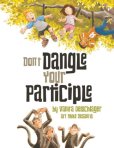 .
.
.
Don’t Dangle Your Participle
.
.

Filed under:
6 Stars TOP BOOK,
Children's Books,
Library Donated Books,
Middle Grade,
NonFiction,
Picture Book,
Top 10 of 2014 Tagged:
children's book reviews,
Civil rights movement,
Civil War,
George Pullman,
Mike Blanc,
Pullman Porters,
vanita books,
Vanita Oelschlager 







 Best Picture Book
Best Picture Book Best Middle Grade Novel
Best Middle Grade Novel Best Nonfiction Book
Best Nonfiction Book Best Poetry Book
Best Poetry Book Best Holiday Book
Best Holiday Book WINNERS: I can offer you the files for your “stamp,” if you are interested. Otherwise this is more bragging rights than anything. Please email (or use contact form). Once again, congratulations to all the winners!
WINNERS: I can offer you the files for your “stamp,” if you are interested. Otherwise this is more bragging rights than anything. Please email (or use contact form). Once again, congratulations to all the winners!




















 x
x










































































































 .
.


 .
.